# SOPs FIR München
EDDM, EDDN, EDDP, EDJA, EDMA, EDMO, EDNY, EDQM, EDDE, EDDC
# EDDM - München Airport
# Overview
A **Tier 1 Endorsement** must be held to staff any position at München Airport or to staff any position covering München Airport top-down.
### München ATC Stations
| **Station**
| **Station ID**
| **Login**
| **Frequency**
|
| **ATIS**
| MX | EDDM\_ATIS | 123.130 |
| **Delivery**
| ML | EDDM\_DEL | 121.730 |
| **Apron 1**
| MP | EDDM\_1\_GND | 121.780 |
| Apron 2
| MP2 | EDDM\_2\_GND | 121.710 |
| Apron 3
| MP3 | EDDM\_3\_GND | 121.930 |
| De-Icing Coordinator | MDIC | EDDM\_I\_GND | 121.990 |
| **Tower / Ground**
|
| Ground North
| MGN | EDDM\_N\_GND | 121.980 |
| Ground South | MGS | EDDM\_S\_GND | 121.830 |
| **Tower North**
| MTN | EDDM\_N\_TWR | 118.705 |
| Tower South
| MTS
| EDDM\_S\_TWR
| 120.505
|
| **Arrival** |
| **Low North** | DMNL
| EDDM\_NL\_APP
| 123.905
|
| **High North** | DMNH
| EDDM\_NH\_APP
| 128.030
|
| Low South
| DMSL
| EDDM\_SL\_APP
| 127.955
|
| High South | DMSH
| EDDM\_SH\_APP
| 120.780
|
| **Arrival Noth** | DMND
| EDDM\_ND\_APP
| 118.830
|
| Arrival South
| DMSD
| EDDM\_SD\_APP
| 132.305
|
### [Quicksheet](https://dms.vatsim-germany.org/s/dNi74bSqpnt7DYy)
### [Quicksheet LVO](http://atc.jan-macherius.de/dateien/Quicksheet_LVOs.pdf "Quicksheet LVO")
# Delivery
### Responsibilities
München Delivery is responsible for issuing enroute and startup clearances for departing IFR traffic in Munich. In addition, Delivery receives the first call of departing VFR flights.
The startup and enroute clearance can be given together in one radio message. Afterwards, Delivery hands over the pilots to the next responsible station (depending on the manned stations, usually Apron 1/2/3).
If startup clearance can not be issued together with enroute clearance, the pilot shall standby on Delivery frequency for startup. Afterwards, pilots shall be handed over to the next station, too. If possible, the pilot shall be informed about an expected time for startup if the expected delay exceeds 10 minutes.
München Delivery is additionally issuing startup clearances for VFR departures. The VFR flight makes his initial call on Delivery frequency, receives startup clearance and will be handed over to the next responsible station.
### SID Assignment
The table below offers an overview of the SID assignment rules..
Departures on the preferred SID are released, clearance can be issued without further coordination. Should traffic be cleared on a non-preferred SID, Delivery shall get approval from Tower prior issuing enroute clearance.
Restrictions exist on all SIDs, thus the phrase "Climb via SID to (level)" shall be used.
Should a pilot report unable to fly a SID, Delivery shall initiate coordination with Tower and Approach (Low sector) about an alternating departure procedure (e.g. vectored departure). Usually the instruction for a vectored departure will be "Fly runway track, climb to Flight Level 70".
Traffic parking on aprons 6-9, especially cargo, should be cleared onto SIDs off the southern runway (RWY 08R/26L) to minimize taxi times.
All departures: **Contact Muenchen Radar when advised by Tower!**
| **Route** | **RWY 08L** | **RWY 08R** | **RWY 26L** | **RWY 26R** | **Max. init. Climb** | **Remarks** |
| **AKINI** | 1Q | 1E | 1S | 1N | FL 70
|
|
| **ALG** *"Allgäu"* | 2Q# | 2E# | 2S | 2N |
|
| **ANKER** | 9Q | 9E | 7S | 9N |
|
| **BIBAG** | 2Q | 2E | 3S / 3W | 4N |
|
| **EVIVA** | 4Q | 4E | 4S | 5N |
|
| **GIVMI** | 6Q | 6E | 6S | 1N |
|
| **INPUD** | 3Q | 3E | 2S | 2N |
|
| **KIRDI** | 2Q | 2E | 3S / 3W | 4N |
|
| **MERSI** | 4Q# / 2T\* | 4E# / 2P\* | 5S | 6N |
|
| **MIQ** *"Mike"* | 9Q | 8E | 8S | 9N | by ATC for non-RNAV only |
| **OBAXA** (Non-Jet)
| 2T\* | 2P\* | 6S\* | 6N\* |
|
| **OLASO** | 2Q | 2E | 2S | 2N |
|
| **RIDAR** | 7Q | 7E | 6S | 6N |
|
| **ROTAX** | 4Q | 4E | 3S / 3W | 4N |
|
| **TULSI** (Jet) | 2Q | 3E | 7S / 4W | 4N | by ATC only |
| **TURBU** (Jet) | 7Q | 6E | 7S / 7W | 7N |
|
| **VAVOR** (Jet) | 3Q | 3E | 3S / 3W | 4N |
|
|
| preferred runway / SID
|
|
|
*W-SIDs= Noise-Protection-SIDs: for A/Cs of WTC H and J between 2200-0600 lcl
\# = Jet only
\* = Non-Jet only*
#### TULSI-Departure
Pilots flying from EDDM to LOWI shall file this route: "TURBU Y107 RTT". If a route via TULSI has been filed, it can be cleared nevertheless after obtaining approval from Approach.
A TULSI departure to any other destination than LOWI should be recleared onto another SID (possible reclearance solutions are included in the Quicksheet), however can be cleared nevertheless after obtaining approval from Approach.
#### Noise Abatement Procedures
Aircraft of Wake Turbulence Category "H" and "J" departing off runway 26L and flying a SID via OTT shall be cleared onto SIDs with designator "W" between 22h and 06h local time.
Departures of aircraft category B747 shall be cleared of runway 08L/26R between 22h and 06h local time. During single (use of) runway operations the active departure runway can be used nevertheless.
### Special Procedures
#### IFR Visual Departures off runway 08R
During active runway 08R, single and two-engine propelled aircraft as well as type DHC7, who fly a SID via VOR OTT (OBAXA#P, MERSI#P), can be offered a visual departure off runway 08R. Following criteria shall be met:
- the pilots accepts or requests the procedure,
- ceiling not below 3400 ft (summer) resp. 3700 ft (winter),
- only during the day,
- initial climb restricted to 5000 ft,
- take-off run commences from full length (intersections B1-B3).
"\[...\] after departure turn right direct OTT, climb to \*altitude\* 5000 feet, maintain own visual reference to terrain until passing 3400/3700 feet"
# Apron
### Areas of Responsibility Apron
The Munich Apron can be divided into three areas of responsibility:
| **Sector** | **Login** | **Station ID** | **Frequency** | **AoR** |
|---|
| **Apron 1** | EDDM\_1\_GND | MP | 121.780
| Apron 1, 6-8 (GAT), 9 (Cargo) and Maintenance |
| **Apron 2** | EDDM\_2\_GND | MP2 | 121.710
| Apron 2 and 12 |
| **Apron 3** | EDDM\_3\_GND | MP3 | 121.930
| Apron 3, 5, 35 and 13 (GAT) |
If more than one Apron is staffed, Delivery must also be staffed. If only one Apron is staffed, it covers all other Apron stations. If Aprons 1 and 2 are staffed, Apron 2 covers Apron 3.
### Handovers Apron - Ground
Depending on the runways in use, Apron only gives taxi clearance up to the respective entry and then transfers the traffic to the next station shortly before the aircraft reaches it.
| **FROM** | **TO** | **ENTRY** |
|---|
| MP | MGN | N1, N2 |
| MP | MGS | S1-S6 |
| MP2 | MGN | N3, N4 |
| MP2 | MGS | S7, S8 |
| MP2 | MP3 | N5, S9 |
| MP3 | MP2 | N5, S9 |
### Orange/Yellow/Blue lines
Taxiways W1, C3, E1, D3, D6 and E3 not only have the standard "yellow line", but also colored lines, "orange line" and "blue line" (see charts). These colored lines have limitations regarding the wingspan of the aircraft and should always be used for pushback or taxiing if the aircraft meets the limitations and the pilot is able to do so. Especially with the use of these colored lines, traffic can be handled as efficiently as possible.
### Taxiway restrictions
- **W1, E1, C3, D6, E3 orange/blue** can be used **simultaneously** by aircraft with **max. 36 m** wingspan (B739/A321).
- **C4** can be used by aircraft with **max. 36 m** wingspan
- **D3 orange/blue** can be used **simultaneously** by aircraft with **max. 52m** wingspan (MD11)
- **K1** can be used by aircraft with **max. 30.5 m** wingspan
- **D6, E3, D3 orange, D3 blue** can be used (individually) by aircraft with **max. 65 m** wingspan
- **D6** on Apron 5 can be used by aircraft with **max. 30 m** wingspan (DH8D)
- **E3** between parking positions 313 and D3 can be used by aircraft with max. 80 m wingspan, between positions 313 and D6 E3 can be used by aircraft with max. 65 m wingspan
- **W2, CTR2 and E2** can be used simultaneously by aircraft with max. 36m wingspan, W2 and E2 can be used simultaneously without limitations
- **D3** is not to be used for "swingover" between W2 and E2 (D1, D2 and D4 are intended for this purpose)
- **Entry N2** can only be used by aircraft with **max. 52m** wingspan
This chart provides an overview:
[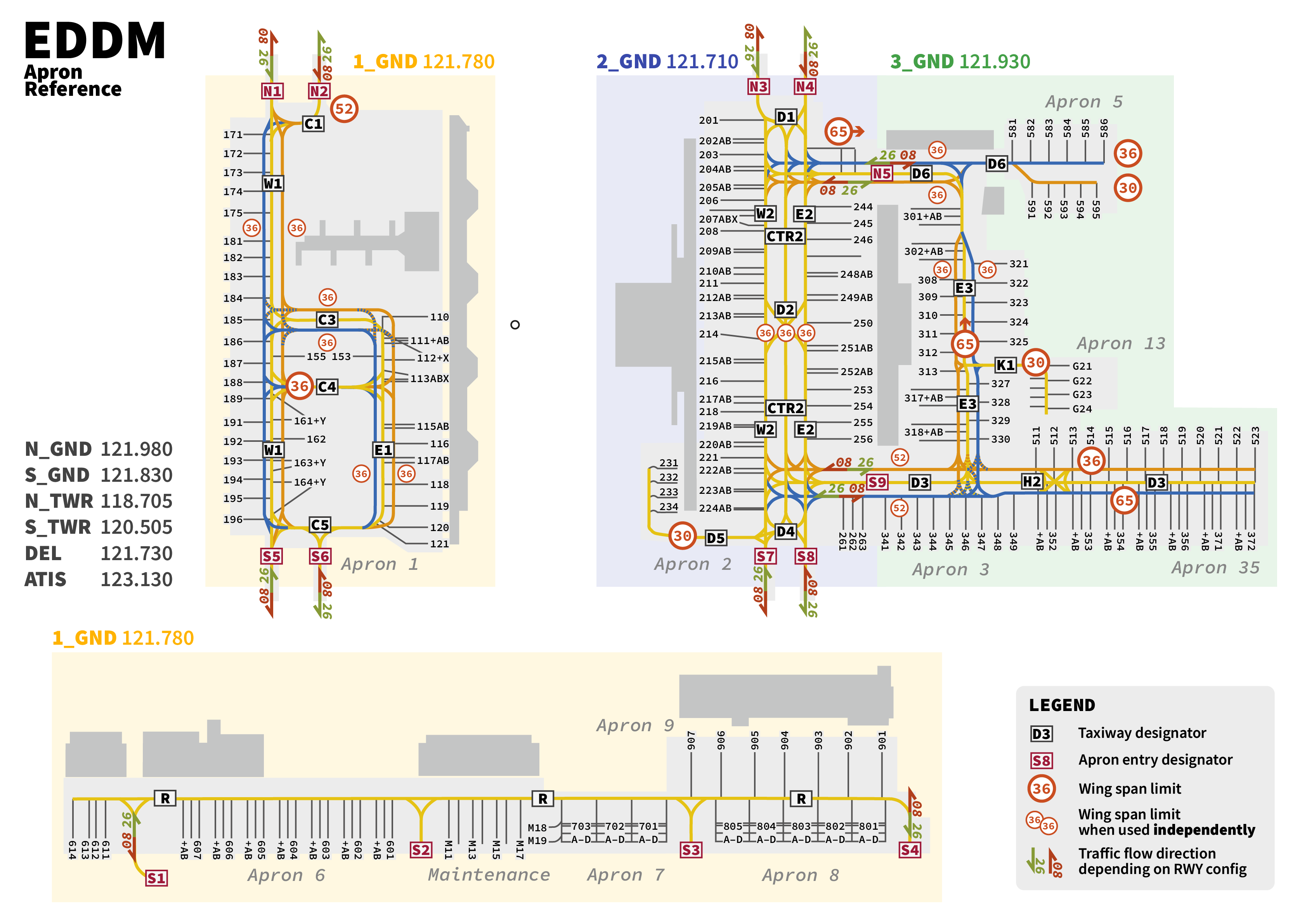](https://knowledgebase.vatsim-germany.org/uploads/images/gallery/2024-02/eddm-apn-2024.png)
*Taxi Restrictions Apron München*
Common aircraft types and their maximum wingspan can be found in this list:
| **Max Wingspan** | **A/C Types** |
|---|
| 30 m | AT72 / CRJX / DH8D / RJ1H / etc. |
| 36 m | B739 / A321 / BCS3 / E195 / etc. |
| 52 m | B753 / B763 / A306 / etc. |
| 65 m | A333 / A346 / A35K / B744 / B77W / B78X / etc. |
| 80 m | A124 / A388 / B748 / etc. |
| >80 m | A225 |
### Usage of the entries
The different entries are used differently depending on the runways in use.
- **08-Operations:**
- **Departures** leave the apron via entries N1, N3, S1-S3, S5 and S7
- **Arrivals** enter the apron via entries N2, N4, S4, S6 and S8
- **26-Operations:**
- **Departures** leave the apron via entries N2, N4, S4, S6 and S8
- **Arrivals** enter the apron via entries N1, N3, S1-S3, S5 and S7
Taxi clearances deviating from the above-mentioned standard procedures are possible after coordination with the station responsible for the ground sector concerned.
### Gate assignment
Gates are usually assigned automatically. Lufthansa and Star Alliance Airlines park on Aprons 2 and 3, other airlines on Apron 1. The general aviation parking area (GAT) is located to the east of Apron 3 on Apron 13. Business aviation can also use aprons 6 to 8, and if a pilot's scenery does not have anything else, resort to Apron 5.
### Special procedures
The following special procedures are generally not to be used for low visibility operations. If visibility is 200 meters or more on the apron, taxiing into parking positions from CTR2 is permitted, but not below.
##### Swingover
A "swingover" refers to the **immediate** change of taxiways. This "swingover" can also take place without following the taxi lanes.
> DLH123, swing over on E2, taxi to Entry S8 via E2.
##### 180-Turn
For example, an aircraft taxiing south on W2 can make a 180° turn to the left onto E2 and then taxi north on E2. This can also be applied to the opposite compass directions and can be done on taxi lines W2, CTR2 and E2. If the wingspan is less than or equal to 36 metres, this procedure can also be applied to blue and ornage lines.
# Ground
### Area of Responsibility Ground
Ground can be divided into two sectors:
| **Sector** | **Login** | **Station ID** | **Frequency** | **Area of Responsibility** |
|---|
| **North Ground** | EDDM\_N\_GND | MGN | 121.980
| Taxiways N and M, all intersections of runway 08L/26R |
| **South Ground** | EDDM\_S\_GND | MGS | 121.830
| Taxiways S and T, all intersections of runway 08R/26L |
If only one ground station is staffed, it covers the AoR of the other ground station as well.
Ground and Apron, resp. two Ground may only be staffed if Delivery is staffed, too.
Ground is usually only staffed after Tower, Apron and Delivery are already staffed.
### Handover
Ground issues a taxi clearance to an entry or a holdingpoint and hands the aircraft over to the next responsible station at the clearance limit.
| **FROM** | **TO** | **ENTRY / HOLDINGPOINT** |
|---|
| MGN | MP | N1, N2 |
| MGN | MP2 | N3, N4 |
| MGN | MTN | A1-A15 |
| MGS | MP | S1-S6 |
| MGS | MP2 | S7, S8 |
| MGS | MTS | B1-B15 |
The handover from Ground to Tower can be instructed as "Contact" or "Standby for". It should be coordinated at the beginning of a session how Tower wants to receive handovers from ground.
> *Contact München Tower \*on\* (frequency) Standby for München Tower \*on\* (frequency)*
##### Departing traffic
Ground receives departing traffic from Apron depending to operation direction at the respective entries. Ground then issues a taxi clearance to a suitable holding point of the departure runway. Ground shall create an efficient departure sequence by assigning a suitable runway intersection, taking SID, WTC and other factors into account. The handover from Ground to Tower should be made as soon as possible.
##### Arriving traffic
Incoming traffic should actually call Ground on its own after leaving the runway. Unfortunately, this rarely works on VATSIM, so incoming traffic is usually handed over by Tower. The traffic receives taxi clearance from Ground to one of the entries as a transfer point. The choice of the entry depends on the planned parking position (Terminal 1 or 2) and the operating direction. Shortly before reaching the entry, the traffic is transferred to the responsible Apron controller.
### Ground movement control
#### Taxi
In order to optimize the flow of traffic, the following taxi routing is recommended:
- N/S opposite to runway direction
- M/T in runway direction
#### Holding Points
The efficient sequencing of traffic at the holding points allows the tower to make optimum use of the available capacity at all times. To achieve this, Ground must route the traffic to the holding points correctly sorted in advance.
##### Sorting by SID
Departures should be processed in such a way that different SIDs depart one after the other, so that a closer spacing can be used (3NM on different SID vs 5NM on same SID).
The three holding points at the beginning of the departure runway should each be used for a different SID, allowing Tower to create an efficient mix of different SIDs.
The goal is to avoid having traffic at the front of all holding points that will fly the same SID.
The most used SIDs in the northern RWY-System often are GIVMI and INPUD,
the most used SIDs in the southern RWY-System often are MERSI, KIRDI and TURBU.
##### Intersection Departures
Pilots have to prepare the following intersections for departure, depending on the aircraft category:
| **Aircraft Category** | **08L** | **TORA** | **08R** | **TORA** | **26R** | **TORA** | **26L** | **TORA** |
|---|
| Heavy+ | A1/A2 | 4000 m | B1/B2 | 4000 m | A14/A15 | 4000 m | B14/B15 | 4000 m |
| Medium Jet | A3 | 3800 m | B3 | 3800 m | A13 | 3800 m | B13 | 3800 m |
| Light Jet | A4 | 2820 m | B4 | 2840 m | A12 | 2780 m | B12 | 2820 m |
| Turboprop | A6 | 2200 m | B6 | 2220 m | A10 | 2260 m | B10 | 2200 m |
These intersections can be assigned to pilots without prior consent. If an intersection departure is not possible for any reason, the pilot must actively report "unable".
# Tower
### Tower Positions
These two Tower Positions exist at München:
| **Sector** | **Login** | **Station ID** | **Frequency** | **Area of Responsibility** |
| **North Tower** | EDDM\_N\_TWR | MTN | 118.705
| Runway 26R/08L |
| **South Tower** | EDDM\_S\_TWR | MTS | 120.505
| Runway 26L/08R |
With both Tower Positions staffed, the controlzone is split abeam the (physical) tower parallel to the runways. North Tower is responsible for the northern part of the CTR, South Tower for the southern part.
If only one tower is staffed, he also takes over the tasks of the other tower. If no Ground is staffed, Tower also takes over the neighbouring Ground AoR (North Tower the North Ground, South Tower the South Ground).
### Handover
| **FROM** | **TO** | **AT** | **RMK** |
|---|
| MGN | MTN | Holdingpoints A1-A15 |
|
| MGS | MTS | Holdingpoints B1-B15 |
|
| DMND | MTN | Final 08L/26R |
|
| DMSD | MTS | Final 08R/26L |
|
| MTN / MTS | MTS / MTN | between the runways
(or as coordinated individually)
| VFR traffic
|
##### Departing Traffic
Tower receives departing traffic at the runway holding points already pre-sorted by the ground. This can be done either with the instruction *"Contact München Tower \*on\* (frequency)"* or *"Standby for München Tower \*on\* (frequency)"*. The type of handover must be coordinated with Ground in advance.
The tower transfers departing traffic to EDDM\_NL\_APP for SIDs departing northbound and to EDDM\_SL\_APP for SIDs departing southbound. The frequencies 123.905 and 127.955 are to be used here. The handover should always take place as early as possible, but only if separation to other traffic is ensured.
There is an exception for parallel departures (lateral distance less than 3 NM), where the handover only takes place as soon as one of the departures turns away from the runway centerline.
##### Arriving Traffic
Tower receives arriving traffic on final approach from Arrival, transfer of communication should not be made before passing the respective Final Approach Fix/Point.
Arriving traffic is instructed to contact Ground on their own initiative after leaving the runway. As this rarely works on Vatsim, it is usually necessary for inbounds to receive a handoff to ground from the tower as soon as they have left the runway correctly (behind the holding point line).
Arriving traffic which is vacating via the High Speed Turnoff directly connected to the Entry used for inbounds (e.g. A9 during RWY26R), should be coordinated between Tower and Ground so that traffic may remain on Tower frequency and receives taxi clearance by Tower.
### VFR Traffic
In München, there are two VFR routes for entering and leaving the control zone, the HOTEL (south) and FOXTROTT (north) routes. There is also a published holding procedure to the north and south of the aerodrome. If required, entry and exit via the Isar (south/east) or the A92 highway (east/west) is recommended to be used, as well.
Depending on the approach route, incoming VFR traffic shall call either the North or South Tower. Traffic calling on the "wrong" frequency shall be identified (e.g. by setting an appropriate squawk), receive RWY in use and QNH before giving handover to the "correct" frequency or giving further clearance after coordination.
VFR crossings should be handed over to the other Tower at the AoR border. After coordination, one Tower can also keep the crossing VFR traffic on his frequency. To transfer VFR traffic between the runways to the other Tower or to delay it until there is a gap, it is advisable to circle around the tower.
The aerodrome circuit of Oberschleissheim (EDNX) leads through the München control zone. Traffic in the aerodrome circuit shall be in radio contact with Schleissheim Radio and does not have to report to the tower or monitor its frequency. Furthermore, the München control zone must be VMC.
##### SSR Codes
The following non-discrete transponder (group) codes can be issued by München Tower for VFR traffic. If required, a discrete transponder code can be assigned:
| **Mode A-Code**
| **Verwendung**
| **Darstellung**
|
| 6305
| VFR traffic within CTR EDDM
| T
|
| 7000
| Groupcode VFR
| V
|
| 7001
| VFR outbounds
| VOUT
|
| 7002
| VFR inbounds
| VIN
|
| 7003-7026
| if required (discrete codes)
| TWR |
- ##### Helicopter Traffic
Helicopters are to be treated as normal VFR traffic. Three helipads are located to the west of Apron 6 and two further helipads are located on Apron 12 to the north of D6 if required. Larger rotorcraft can also be parked on Apron 6 next to the helipads. Direct landing on the helipads is not permitted. Helicopters stationed at the airport however, such as those of the Bavarian State Police (ICAO CODE: EDW), can take off and land on the helipad in both directions. All other helicopters take off and land on the runways.
### Operating Direction and use of the Runways
##### Choice of operating direction
- Tower is responsible for determining the operating direction
- Operating direction 26 is preferred and should be used in case of doubt
##### Use of Runways
The two runways 08/26 in Munich can be used independently of each other. Nevertheless, in case of various conditions such as traffic volume, weather, etc., sometimes only one runway can be used for take-off and landing or one runway for take-off and the other for landing (see below).
If departures always use the preferred runway (and SID), take-off clearances can be issued on both runways simultaneously and independently of each other. Particular attention should be paid to departures of cargo aircraft from the southern runway flying northwards (INPUD, GIVMI, etc.). These are no longer independent of departures on the northern runway, meaning that no departures may take place there at this time until separation is ensured.
Approaches are also independent of each other and ILS approaches can even take place in parallel. If the controller \[during a parallel approach using the ILS\] detects course deviations in one of the approaching aircraft that reduce the lateral separation, not only the deviating aircraft is requested to perform an avoidance manoeuvre, but also the aircraft on the parallel approach, even if it is on the correct final approach.
##### Examples for Runway Configurations
- **Independent OPS:** Both runways can be used for take-offs and landings. ILS approaches and departures on **preferred** SIDs are independent of each other.
- **Single Use of Runway OPS:** One runway is only used for take-offs, the other only for landings. The preferred runway is 08L/26L for take-offs and 08R/26R for landings. This runway configuration is recommended for Low Visibility Procedures (LVP). Take-offs and landings are also independent here, as the published G/A procedures are separate from all departures.
- **Single Runway OPS:** In winter conditions and when the runway(s) must be treated and therefore being closed accordingly, this runway configuration is used, in which only one runway is used for take-offs and landings; the south runway (08R/26L) is preferred.
##### Change of Operating Direction
- TWR decides on a change of operating direction in coordination with Arrival and arranges a specific time for this
- ALL other stations are informed of the change of direction. The traffic on the ground and in the
air will be resequenced and recleared accordingly
- Tower reports the last departure of the old operating direction for each runway to all Approach controllers and Director
- The Arrival controllers report the last planned approach to Tower in the old operating direction for each runway
- Director informs the responsible Tower about the first arrival in the new operating direction during the base turn of the flight
- No intersection departures are permitted during the changeover until the last aircraft has left the runway
### Arrivals
##### Separation on Final
- Generally, the responsibility for separation of flights subject to separation in CTR München (Airspace D) lies with Tower.
- The responsibility for separation of IFR-Arrivals on Final (not Visual Approach) lies with Director.
After Transfer of Communication, München Tower shall monitor separation and (if necessary) shall take appropriate measures to maintain separation.
- Reduced separation on final may be applied, if all requirements are fulfilled: In this case the separation on Final may be reduced to 2.5 NM, as long as both involved aircraft are in contact with Tower.
- Assignment of speeds on Final by Tower are permitted without coordination. However, it is recommended to inform the responsible Arrival controller about speeds assigned. After speed assignment by Tower, responsibility of separation for all involved flight lies with Tower!
##### Independent Parallel Approaches
- Generally, Independent Parallel Approaches are in operation.
- Independent Parallel Approaches can be used when operating ILS or RNP approaches.
- The NTZ shall be displayed on the PHX radar scope.
- Whenever NTZ is penetrated, a Missed Approach shall be instructed to reassure separation.
##### Missed Approaches
Tower is responsible for separation of Missed Approaches to all other flights subject to separation within CTR München. In case of a missed approach, the respective "Low" controller (DMNL / DMSL) is to be informed immediately. Callsign, planned Runway and reason for the missed approach shall be communicated to Low. Low may restrict following departures as "subject to release" (rf. [Departure Release)](https://knowledgebase.vatsim-germany.org/books/coordination/page/departure-release).
Missed Approaches should generally follow the published Missed Approach Procedure, as it is independent to departures of the parallel Runway. After coordination with Low, alternate instructions may be instructed to the pilot (e.g. vector on the downwind, runway track, etc.)
### Departures
##### Separation between Departures
For departures that depart via the same SID or via the SID combination KIRDI/BIBAG and ANKER/AKINI, the previous departure must be at least 5 NM on the SID (track miles) from the end of the runway before the following departure flies over the departure end of runway.
The performance of the aircraft types must also be taken into account in order to prevent a loss of spacing due to different speeds.
Wake Turbulence Separation shall be applied at all times!
##### Intersection Departures
Following table shows the Intersection and TORA pilots have to expect. Deviations from this scheme always require the prior consent of the pilot.
| **ATYP** | **08L** | **TORA** | **08R** | **TORA** | **26R** | **TORA** | **26L** | **TORA** |
|---|
| **Heavy+** | **A1/A2** | 4000 m | **B1/B2** | 4000 m | **A14/A15** | 4000 m | **B14/B15** | 4000 m |
| **Medium Jet** | **A3** | 3800 m | **B3** | 3800 m | **A13** | 3800 m | **B13** | 3800 m |
| **Light Jet** | **A4** | 2820 m | **B4** | 2840 m | **A12** | 2780 m | **B12** | 2820 m |
| **Turboprop** | **A6** | 2200 m | **B6** | 2220 m | **A10** | 2260 m | **B10** | 2200 m |
Intersections A5, A8, A9 as well as B7, B8, B11 are not permitted for lining up on the runway. Intersections A7 and B9 are not to be used in general.
##### Conditional Line Up on Intersections
To guarantee the correct identification of Traffic during a conditional Line-Up on Intersections, which are not in a right angle to the runway, a traffic information and a confirmation that traffic is in sight is required **prior** to line up clearance.
This is not necessary for conditional line ups from the beginning of the runway (e.g. A1-A3)
Specifically, traffic shall be reported "in sight" before a conditional clearance is issued for the following intersections: A4/A6, B4/B6 or A10/A12 and B10/B12.
> C: DLH123, traffic, A320, 2NM final runway 26R, report traffic in sight.
>
> P: DLH123, traffic in sight.
>
> C: DLH123, behind mentioned traffic line-up RWY 26R, behind.
As with all traffic information, a more detailed description of the traffic is not absolutely necessary, but can be helpful for the pilot.
##### Noise Abatement between 2200 and 0600 lcl
During nighttime, departures are not to be cleared below FL70.
## Low Visibility Procedures
The ILS in München is certified for CAT IIIb operations.
Low Visibility Operations are conducted in Single Use of RWY OPS, individual approaches may deviate from this.
Active LVP shall be broadcasted in the ATIS by adding &lvp to the [ATIS Maker URL](https://knowledgebase.vatsim-germany.org/books/sops-fir-munchen/page/atis-codes-edmm):
> LOW VISIBILITY PROCEDURES IN OPERATION CAT II AND III AVAILABLE
#### Separation during LVP
##### Arrivals to Arrivals
München applies the **Landing Clearance Line** (LCL) procedure of preceding aircraft of WTC **Medium (M)** and **Light (L)**, which means: If an aircraft of WTC Medium or Light has **vacated** the **runway**, **passed** the **LCL** and is **still in movement** the next arrival may be overflying the threshold. If the preceding arrival has not yet passed the LCL, a Go Around shall be instructed.
Aircraft of WTC **Heavy (H)** need to vacate the **CAT II/III Holding Point** before the next arrival can pass 2 NM on final. If the next arrival passes 2 NM final and the Heavy did not vacate the CAT II/III Holding Point, a Go Around shall be instructed.
Aircraft of WTC **Super (J)** need to **reach TWY N** respective **TWY S** before the next arrival may pass 2 NM on final. If the next arrival passes 2 NM final and the Super did not reach TWY N/S, a Go Around shall be instructed.
##### Departures to Arrivals
To ensure ILS signals are not interfered with, all departures need to be clear of the
- **critical area** before any succeeding arrival is less than **4 NM** out, and
- **sensitive area** before any succeeding arrival is less than **2 NM** out.
This separation applies irrespective of the WTC of the involved aircraft, and a missed approach is to be instructed if separation is not achieved. Both critical and sensitive areas can be shown by activating the *LVP / Critical Areas* map in the Ground Radar.
##### Departures
Between two departures **full Runway separation** shall be applied.
During use of **Guided Take Off** it shall furthermore be ensured that a preceeding departure has overflown the Localizer or a preceeding arrival has vacated the CAT II/III Holding Point before the succeeding aircraft starts it's take off roll.
# Approach
### Sectorization
As per the reference drawing below, the München TMA airspace can be divided into four sectors. The two feeder positions (Callsign "Arrival", formerly "Director", DMNAT and DMSAT) do not have their own airspace assigned, but share airspace and implicitly receive a release when airplanes are sent to them. A portion of the München TMA airspace is of class G, thus not subject to air traffic control services. MVA (minimum vectoring altitudes) can be found in the published DFS charts (e.g. via [chartfox.org](https://chartfox.org/EDDM)).
[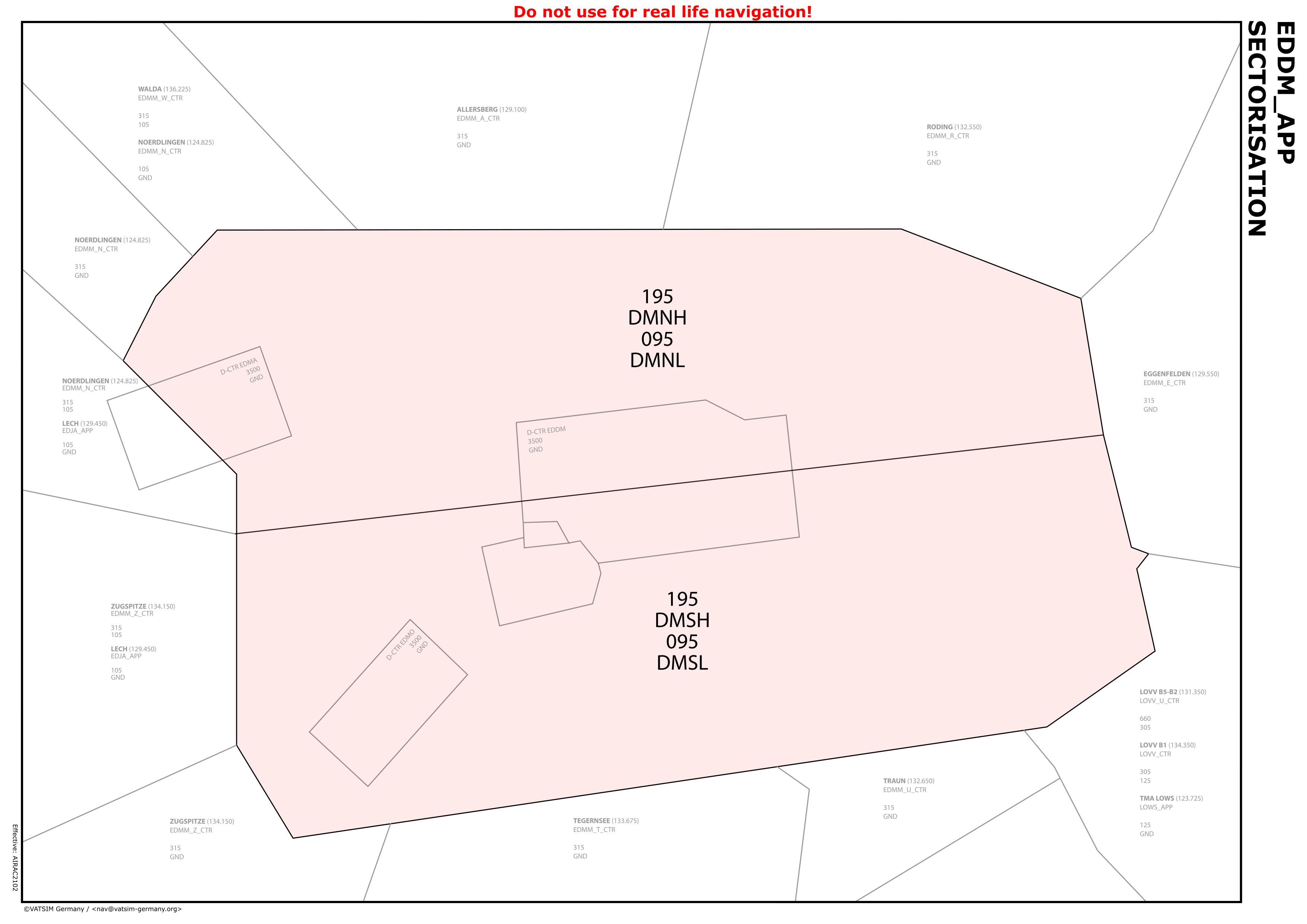](https://knowledgebase.vatsim-germany.org/uploads/images/gallery/2022-09/eddmappsector.png)*München Arrival Sectorization*
The following station identifiers are used in the overview:
| **Station Identifier** | **Euroscope ID** | **Station** | **Frequency** |
|---|
| DMNL
| DMNL | München North Low | 123.905 |
| **DMNH**
| **DMNH** | **München North High** | **128.030** |
| DMSH
| DMSL | München South Low | 127.955 |
| DMSL
| DMSH | München South High | 120.780 |
| **DMNAT**
| **DMND** | **München Arrival North** | **118.830** |
| DMSAT
| DMSD | München Arrival South | 132.305 |
**DMNH is the primary station and to be staffed first. Without any further stations online, this station covers the complete TMA. The second station to be staffed is Arrival North (DMNAT).**
After DMNH and DMNAT are staffed, there are two strategies for further staffing:
- **North/South split:** The next station after DMNH and DMNAT is DMSH: The border is drawn as per the drawing above.
- **High/Low split:** The next station after DMNH and DMNAT is DMNL: DMNL and DMNH split the airspace vertically at FL95.
Thereafter, the remaining stations can be staffed in any order. Note that in the combination (DMNH, DMNL, DMSH), DMSH staffs the southern half of the TMA, DMNL is restricted to the upper half.
Cross-couple (XC) all frequencies of the sectors your station covers (apart from the Feeder)!
As stand-alone DMNH, for example, you should cross-couple DMNL, DMSL, DMSH; as DMNAT (without DMSAT online), cross-couple DMSAT as well.
DMSAT is only to be staffed, after DMNL, DMNAT and DMSL are staffed. Two-feeder independent operations are in effect.
### Arrivals
#### STARs
**The STARs in München** have their clearance limit at the first waypoint and **are usually not used.** The only exceptions are lost communication situations and non-RNAV flights. The procedures lead pilots from the clearance limits to the initial approach fixes of the approach procedures (MIQ in the north, OTT in the south).
#### Transitions
To bring planes onto a controlled arrival procedure within the TMA, clear pilots to fly the RNAV transitions starting at the STAR clearance limits and bringing planes into an up- and/or downwind. High and Low can clear arrivals to any of the DMXXX waypoints on the transitions to generate or reduce track miles without prior coordination. Should the direct be situated beyond DM425/DM454 (26 ops) or DM425/DM455 (08 ops), coordination is highly suggested to avoid conflicting with crossing departures.
The München procedure package also includes CDO (continuous descent operations) transitions that can be cleared in coordination with center. The usage of the CDO transitions is only recommended during periods of low traffic.
#### Approach procedures
München offers a CATIIIB certified ILS approach for either runway in either direction, as well as published RNP, and NDB approach procedures. ILS is the preferred approach type.
Visual approaches for IFR traffic are generally not permitted, except for visual approaches on final.
#### Independent Parallel Approaches
München is authorized to operate Parallel Independent Approaches, meaning that both finals are completely independent to each other as long as all approaching aircraft are either maintaining radar separation or laterally established on the approach procedure and do not penetrate the Non Transgression Zone (displayed in TWR Radar). There are some restrictions that need to be complied with:
- Independent Parallel Approaches need to fly an ILS approach **or**
- an RNP Approach with vertical guidance (LNAV-only is not authorized, this is desribed on the approach charts as well)
- Intercept headings need to be ≤ 30 degrees to the final approach track.
- 1 NM straight and level on the intercept heading,
- 2 NM straight and level on the final approach course.
Also refer to [this general information ](https://knowledgebase.vatsim-germany.org/books/separation/page/procedural-separation#bkmrk-unabh%C3%A4ngige-parallel)about Independent Parallel Approaches.
Only **one** Feeder is required to conduct Independent Parallel Approaches in EDDM.
##### Two-feeder operations
Final approaches into München can be managed by one or two Feeder positions. Before opening the second feeder position, DMNL, DMSL and DMNAT need to be staffed. Staffing the second Feeder position is not(!) required to operate parallel independent approaches. If two feeders are staffed, DMNL and DMSL are responsible for assigning the runways. Planes on the northern downwind use the northern runway, planes on the southern downwind the southern runway. Exceptions are possible (cargo), but absolutely have to be coordinated in time.
To keep the amount of required coordination low, we employ **prescribed intercept areas** and intercept altitudes.
There is the **low final,** where planes intercept the localizer at **5000ft (or 4000ft),** and the **high final** where planes are to intercept the localizer at **6000ft (or 5000ft)**. During **26 operations,** the **low final is north, during 08,** it is in the **south.**
The low final is shown with the additional intercept "boxes" along the extended centerline. The intercept box between 13 NM and
16 NM final shall only be penetrated by aircraft maintaining 4000ft, the "open" intercept box ending at 16 NM final shall only be penetrated by aircraft maintaining 5000ft. The line parallel to the final closing the 4000ft box ensures 3 NM distance to the high final.

| **WTC preceding A/C** | **Spacing** |
|---|
| Light (L) / Medium (M) | 3,5 NM |
| Heavy (H) | 6 NM |
| Super (J) | 8-10 NM |
### Arrival Agreements
#### Center to High
- **26 ops**
| **Transferring Sector** | **COPX** | **Level** | **Optional Levels** | **Release** | **DCT** |
| **NDG** | LURER / RIDAR | FL160
| -- | ↔ ↓ FL110 at FL195 or below | ROKIL |
| **WLD** | BURAM / RENLO | FL170
| FL150 / FL130 / FL110
|
| **RDG** | GOMAX / KUFAZ / OSTES | FL110 | FL110 - FL130 | ↔ ↓ at FL195 or below | LANDU |
| **EGG** | ROSAB |
| **FUE** | DISUN / MERSI
| FL160 | -- | ↔ ↓ north of L608 | -- |
| **STA** | ANDEC / KONIN
| FL150 | FL130 |
- **08 ops**
| **Transferring Sector** | **COPX** | **Level** | **Optional Levels** | **Release** | **DCT** |
| **NDG** | LURER / RIDAR
| FL140 | -- | ↔ ↓ FL110 at FL195 or below | ROKIL |
| **WLD** | BURAM / RENLO | FL130 | FL110 |
| **RDG** | GOMAX / KUFAZ / OSTES | FL170 | FL110 - FL170 | ↔ ↓at FL195 or below | LANDU |
| **EGG** | ROSAB |
| **FUE** | DISUN / MERSI
| FL120 | FL140
| ↔ ↓ north of L608 | -- |
| **TEG** | ANDEC / KONIN
| FL130 | FL150 |
- **Releases**
| **Routing** | **Release** | **Released by** |
| ANORA / AKANU | ↓ to FL110 | ↔ below FL195
| CTR |
| LURER | ↓ to FL110 | ↔ after LURER | CTR |
| LANDU | ↓ ↔ below FL195 | CTR |
| BETOS | ↓ ↔ after passing airway L608 | CTR |
| ANORA / AKANU / LURER | DCT ROKIL | APP |
| LANDU | DCT LANDU | APP |
#### High to Low
Arriving traffic is handed over established on the upwind or downwind at the following altitudes with an assigned speed of 220–240 kt IAS (exceptions depending on the traffic situation are possible):
- Aircraft on the upwind are to be cleared to descend to FL100,
- Aircraft on the downwind are to be cleared to descend to FL110.
With transfer of communication, all aircraft are fully released.
#### Low to Arrival
Arriving traffic is to be handed over to München Arrival at 220 kt IAS. Higher speeds are acceptable depending on the traffic situation.
Traffic is to be handed over with the following conditions:
| **Position** | **RWY 26** | **RWY 08** | **Release** |
| Downwind N | ↓ 5000 ft | ↓ 6000 ft | fully released at transfer of communication |
| Downwind S | ↓ 6000 ft | ↓ 5000 ft |
After coordination with München Arrival, High and Low can hand over arriving traffic on the base leg or a dog leg under the following conditions:
| **Position** | **RWY 26** | **RWY 08** | **Release** |
| Base/Dog-leg N
Crossing of the downwind | 5000 ft | 6000 ft | fully released at transfer of communication |
| Base/Dog-leg S
Crossing of the downwind | 6000 ft | 5000 ft |
**All aircraft transferred to Arrival shall be issued the current local QNH and cleared to an altitude on local QNH.**
#### Arrival to Tower
Arrival generally is to only hand over arrivals that are established on a published arrival procedure to tower. Visual final approaches are to be coordinated with Tower.
Separation between two arrivals on the same arrival procedure or runway shall at all times equate to or surpass the applicable radar and wake turbulence separation. Arrival shall monitor the departing traffic situation at the runway holding points and increase separation on final to allow departures to use the resulting gaps. Notwithstanding, tower can always request specific and further increased separation on final.
#### Separation recommendations during LVP
During Low Visibility Procedures, increased separation required for runway movements is to be established on the final as well. Experience has shown these separation minima work well between two arrivals:
| **WTC preceding aircraft** | **Separation** |
| Light (L) / Medium (M) | 3,5 NM |
| Heavy (H) | 6 NM |
| Super (J) | 10 NM |
### Departure Agreements
#### Low to High
Departures on the GIVMI, INPUD, EVIVA, MIQ, ANKER, AKINI, OBAXA, TURBU, and VAVOR departures are transferred from Low to Center climbing to FL 150/190. Low shall ensure separation to aircraft within the High sectors at all times.
All other departures are cleared by Low to climb to FL90 and are sent to High (climbing). After coordination with High, Low can also send these Departures directly to Center.
#### High to Center
High can generally clear departures direct to the SID end fix. For same routes, if a minimum separation of 5 NM cannot be established at time of transfer, the departure aircraft are to be handed over on different flight levels. For differing routes, 3 NM separation are acceptable as well.
Exceptionally, High can transfer departures to Center on a heading. In this case, pilots shall be instructed to report their heading to the Center controller during their initial call.
These procedures can likewise be applied to departures handed over directly from Low to Center.
#### Level Agreements
| **SID** | **Runway** | **Level** |
| **North** |
| AKINI / ANKER / EVIVA / GIVMI / INPUD / MIQ | ALL | FL190 |
| RIDAR | 08 | FL180 |
| 26 | FL140 |
| **South** |
| ALG / BIBAG / KIRDI / MERSI / OLASO | ALL | FL190 |
| OBAXA / ROTAX / TULSI / TURBU / VAVOR | ALL | FL150 |
#### Released Directs by Center
| **Routing** | **Restricted Airspace** | **Directs released** |
| MOMUK / UMTEX | **inactive:** TRA Allgäu (107/207) | RAVED / UMTEX |
| ANKER / AKINI | **active:** ED-R 170 ; **inactive:** ED-R 138 | AKINI |
| ANKER / AKINI | **RWY26 only, inactive:** ED-R 170 **und** ED-R 138 | RUDNO |
| INPUD
| **/** | UPALA
|
#### Releases by Arrival
All aircraft sent by all München approach units are considered as fully released for climb, descend, turns, and speed control upon transfer of communication.
### Agreement and Procedure Quicksheets
[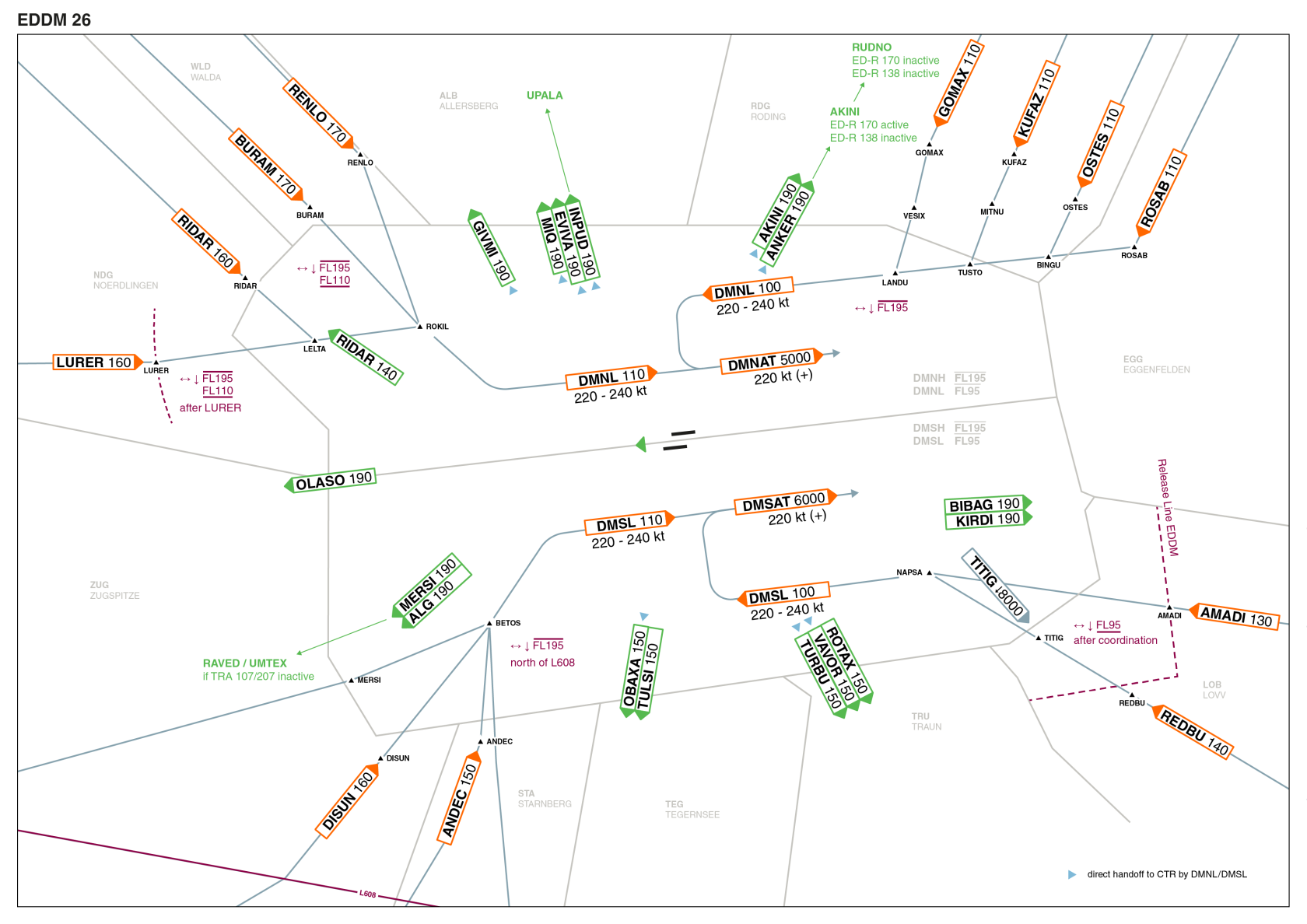](https://knowledgebase.vatsim-germany.org/uploads/images/gallery/2024-07/loa-eddm-app-26-2406.png)
[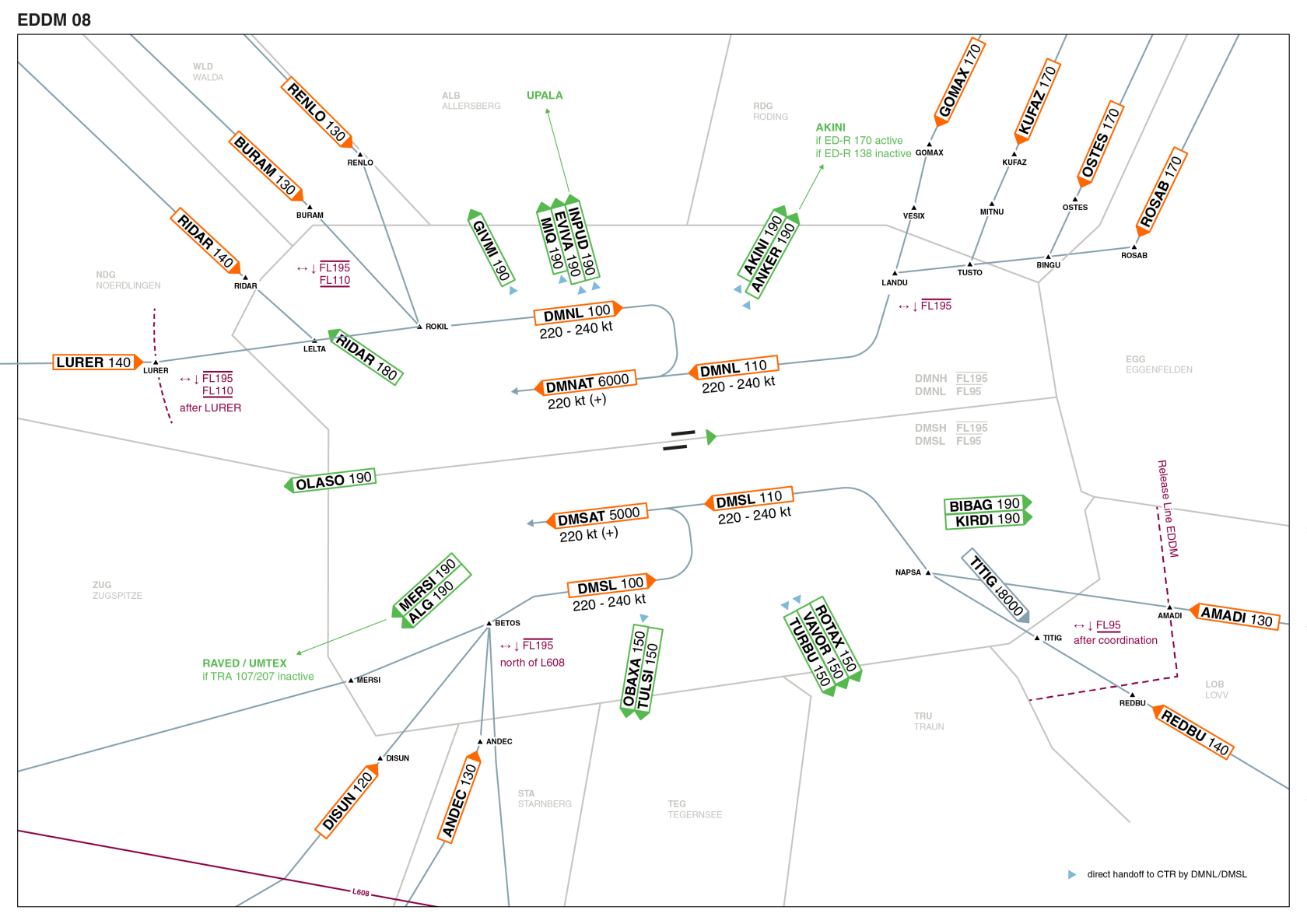](https://knowledgebase.vatsim-germany.org/uploads/images/gallery/2024-07/loa-eddm-app-08-2406.png)
# EDDP - Leipzig Airport
# Overview
### Leipzig ATC Stations
| **Station**
| **Station ID**
| **Login**
| **Frequency**
| **Remark**
|
| **ATIS** | PX | EDDP\_ATIS | 123.955 | |
| **Delivery**
| PL
| EDDP\_DEL
| 121.680
|
|
| **Ground** | PG
| EDDP\_GND
| 121.805
|
|
| Tower North | PTN
| EDDP\_N\_TWR
| 125.955
|
|
| **Tower South**
| PTS
| EDDP\_S\_TWR
| 121.105
|
|
| **Arrival**
|
| München Radar
(Thüringen Low North)
| TRN
| EDDP\_TRN\_APP
| 126.065
|
|
| **München Radar**
**(Thüringen Low South)**
| TRS
| EDDP\_TRS\_APP
| 126.175
| Covering sector SAS (Sachsen Low) if not staffed
|
| Feeder North "Arrival"
| DPND
| EDDP\_ND\_APP
| 120.840
|
|
| **Feeder South "Arrival"**
| DPSD
| EDDP\_SD\_APP
| 129.765
|
|
# Delivery
### Responsibilities
Leipzig Delivery is responsible for issuing IFR enroute clearances and startup approval.
### SID Assignment
- Aircraft on Aprons 2 and 4 usually get the southern runway
- Aircraft on Aprons 1 and 3 usually get the northern runway
- The aircraft types A346/B77W/B744/B748/A388 are prefered for the southern runway
|
| **DRN** | **GOLAT** | **NEVKO** | **ORTAG** | **PENEM** | EDDP | **CLIMB** |
| **26R** | **2N** | **2N** | **2N** | **5N** | **1N \*** | 1N | **FL 070** |
| **26L** | **1L**
2S **\***
| **2S** | **2S** | **5S** | **1S \*** | 1S |
| **08R** | **2E** | 1K **\***
**2E**
| 1K **\***
**2E**
| **5E** | **1E** | 1E |
| **08L** | **2Q** | **2Q** | **2Q** | **5Q \***
1X
| **1Q \***
1X
| 1Q |
- **\*** Climb via SID
- **Marked** are preferred
- Day Departures only (0600 lcl - 2200 lcl)
- MTOW below 136 tons only
- EDDP Departures are omnidirectional - for NON-RNAV equipped aircraft only!
### Invalid routes (re-clearances)
If a pilot has filed an invalid route but can fly the latest SIDs, these re-routes shall be used:
- - RUDAK --> PENEM Y236 RUDAK
- ODLUN --> PENEM Y233 ODLUN
- UMBAL --> PENEM Z131 UMBAL
- MAG --> PENEM Y233 ODLUN Z207 MAG
### Datalink Clearance (PDC/DCL)
Leipzig/Halle Airport has a Datalink Clearance System. EDDP is to be used as the log-in code.
# Ground
Leipzig Ground is responsible for all taxiing traffic on the aprons and taxiways, as well as pushbacks.
### Taxiways Apron 4
The taxiways at Apron 4 (DHL Apron) are called "Blue" or "Orange" Line despite their designation. The respective bays are internally referred to as A-bay, B-bay, ..., E-Bay.
| **Bay** | **Taxiway 1** | **Callsign** | **Taxiway 2** | **Callsign** | **Taxiway 3** | **Rufname** |
|---|
| **A-Bay** | Z1.1 | Z1 orange | Z1.2 | Z1 blue | - | - |
| **B-Bay** | Z2.1 | Z2 orange | Z2.2 | Z2 blue | - | - |
| **C-Bay** | Z3.1 | Z3 orange | Z3.2 | Z3 blue | - | - |
| **D-Bay** | Z4.1 | Z4 orange | Z4.2 | Z4 | Z4.3 | Z4 blue |
| **E-Bay** | Z5.1 | Z5 orange | Z5.2 | Z5 | - | - |
These taxiways are usually not used on frequency. **To avoid conflicts, they shall be given anyway!**
Departing aircraft push to the nearest taxiway within the bay according to their wingspan.
####
### Taxiway restrictions
| ##### **Taxiways/Holdinspoints/Apron**
| ##### **Restrictions**
|
| Taxiways M und H2 | Max. wingspan 52 m
|
| Taxiway L between Stands 101-111 | Max. wingspan 36 m
|
| Taxiway S6 | Turning westbound onto taxiway T is prohibited
|
| Apron 4 | - Taxiways: Z1.1, Z1.2,Z 2.1, Z2.2, Z3.1, Z3.2, Z4.1, Z4.3, Z5.1 max. wingspan 52 m
- Simultaneous use of Z4.2 with Z4.1/Z4.3 is prohibited, the same applies to Z5.2 and Z5.1
|
| Taxiway V (between S2 and Y) | Max. wingspan 65 m
|
| Holdingpoints S1-S10 | No taxiing behind it on taxiway T possible at the same time
|
| Holdingpoints A1, A2 | - No traffic on both taxiways at the same time (CATI)
- No simultaneous traffic on both taxiways if the wingspan of one aircraft is more than 52m (CATII/III), but this only applies if the second traffic is taxiing from taxiway C to A2
|
| Holdingpoints A8, A9 | No traffic on both taxiways at the same time if the maximum wingspan of an aircraft exceeds 52m
|
Map following shortly :) .
### Gate Assignments
#### Apron 1
The passenger terminal and the GAT are located on apron two. All passenger and sports aircraft are parked here.
| **Stands** | **Usage** |
|---|
| **101 - 111** | Airlines; aircraft that do not require a jetway |
| **112 - 121** | Mainly business jets and private aircraft |
| **126 - 130** | Airlines (Schengen); aircraft that require a jetway |
| **132 - 136** | Airlines (non-Schengen); aircraft that require a jetway |
| **137 - 143** | General Aviation (GAT) |
At stands 101-111, aircraft are usually parked with their nose to the south. Thus they are taxi out stands. Aircraft with their own stairs (e.g. CRJ) are also parked at stand 130 and handled by "walkboarding"
#### Apron 2
Apron 2 is mainly used by cargo aircraft that do not fly in the DHL network, but in some cases also by aircraft from the DHL Group. Parking stands are available for every aircraft category.
#### Apron 3
There is a parking area and a hangar for aircraft of the airline Volga-Dnepr-Airlines.
The virtual airline "Leipzig Air" also has a fictional apron here. This is not available in the ground layout and is only released when explicitly requested by the pilot.
#### Apron 4/5
Only aircraft operating flights within the DHL network park on apron 4. There are several parking positions for each aircraft type. There are also restrictions for some parking positions due to the maximum authorised wingspan of the aircraft. All restrictions are implemented in the latest version of the Groundradar plug-in.
The following airlines mainly fly to Leipzig as part of the DHL network:
| ICAO-Code | Airline | Callsign |
|---|
| **ABR** | ASL Airlines Ireland | CONTRACT |
| **BCS** | European Air Transport | POSTMAN |
| **BOX** | AeroLogic | GERMAN CARGO |
| **CKS** | Kalitta Air | CONNIE |
| **DHA** | DHL Air Austria | YELLOW TAIL |
| **DHK** | DHL Air UK | WORLD EXPRESS |
| **DHX** | DHL Middle East | DILMUN |
| **GTI** | Atlas Air | GIANT |
| **MNB** | MNG Airlines | BLACK SEA |
| **PAC** | Polar Air Cargo | POLAR |
| **SOO** | Southern Air | SOUTHERN AIR |
| **SOP** | Solinair | SOLINAIR |
| **SRR** | Star Air | WHITESTAR |
### High Intensity Runway Operation (HIRO)
At night (between 2200lcl and 0600lcl) all B752/A306/B763 on the southern runway are expected to vacate via S6 (RWY08L) or S4 (RWY26L). Aircraft that are parking on Apron 4/5 will vacate via S6/S4 cross T and hold short of V unless otherwise instructed by Tower (this only applies during HIRO).
Be careful when assigning intersection H5 with runway 26 in operation, as nose-to-nose conflicts can quickly develop here if an arriving aircraft vacates and a departing aircraft taxies onto the intersection.
If you are unsure whether you can assign the intersection, coordinate with the tower controller as he can instruct the arriving aircraft to vacate later if necessary.
The same applies during HIRO operations on taxiway V and T, as the traffic vacates, crosses T directly and holds short of V without having to contact ground, which can easily lead to cleared conflicts.
# Tower
### Tower positions
In Leipzig there are the following two tower positions:
| **Station** | **Station ID** | **Login**
| **Frequency**
|
| Tower North
| PTN
| EDDP\_N\_TWR
| 125.955 |
| Tower South
| PTS
| EDDP\_S\_TWR
| 121.105
|
If both tower positions are staffed, the CTR is split in half in the middle, parallel to the runways. The north tower is responsible for the northern half of the CTR, the south tower for the southern half.
If only one tower is staffed, it also takes over the duties of the other tower and **cross couples both frequencies**.
### Departing traffic
Leipzig Tower receives all departing aircraft at the holding point. Once they are airborne they have to be handed over manually to the corresponding departure frequency:
| 126.065 | 126.175 |
| PENEM | NEVKO |
| ORTAG | GOLAT
|
| - | DRN
|
There is an exception for parallel departures (lateral distance less than 3 NM), where the handover only takes place as soon as one of the departures turns away from the extended centerline.
#### Parallel departures
To use parallel departures the following criteria must be met:
- All aircraft are flying a published departure procedure
- It must be ensured that the departure routes do not cross! Coordination with the other tower is ecessary!
- Leipzig Tower must ensure that all involved aircraft do not turn before the published turns in the departure procedure. If one aircraft deviates from the extended centerline before the published turn, it and all other aircraft, that are closer than 3NM have to be turned away from the extended centerline immediately!
- Both aircraft are handed over to the departure frequency once one of them turns away from the extended centerline (or the radar seperation is given) as published in the departure procedure.
It is possible that aircraft with a good climb performance reach theirn initial climb (FL70) before one of them turns away from the extended centerline. To prevent an aircraft from levelling out, you can request a higher level from the responsible approach controller.
S\_TWR always needs a release from N\_TWR for departures to the north (ORTAG, PENEM)
N\_TWR always needs a release from S\_TWR for departures to the south (NEVKO, GOLAT, DRN)
### Arriving traffic
Leipzig Tower receives all arriving aircraft one of the published approach procedures unless otherwise coordinated (e.g. visual approach). When the aircraft vacates the runway, they must be handed over to the ground controller.
#### RECAT-EU procedures
Leipzig is one of the airports at which the DFS approved the use of the RECAT-EU procedures.
**The use of them is only allowed for the category "Lower Heavy/Upper Heavy" and "Lower Heavy/Lower Heavy", these are the aircraft types: **
| ##### **Upper Heavy**
| ##### **Lower Heavy**
|
| **A330** | **A300** |
| **A340** | **A310** |
| **A350** | **B703** |
| **B747** | **B757** |
| **B777** | **B767** |
| **B787** | **B783** |
| **IL96** | **C135** |
|
| **DC10** |
|
| **DC85** |
|
| **IL76** |
|
| **MD11** |
|
| **TU22** |
|
| **TU95** |
According to the procedure 2 of the above aircraft types only have to be separated 3NM (wake turbulence) unless another method of separation (e.g. radar separation) requires more.
The pilot can refuse this procedure at any time, but shall inform you early.
Caution between Upper-Heavy and Lower-Heavy! The "Lower Heavy" must be preceding!
Mediums are excluded from this procedure!
Fore more information: [Eurocontrol](https://www.eurocontrol.int/sites/default/files/2021-07/recat-eu-released-september-2018.pdf)
#### Modes of Operation
he mode of approach is specified by the approach controller and coordinated to the tower.
Leipzig is authorised for the use of the following types of separation between aircraft on different finals:
Independent parallel approaches
When using independent parallel approaches both finals are completely independent.
To use parallel independent approaches, the following criteria must be met:
- Both Tower and Director positions must be staffed
- All aircraft involved must use precision approaches (the only precision approach that is available in Leipzig is the ILS approach)
- If an aircraft deviates from the final approach path, it and any other aircraft on the adjacent approach that is closer than 3NM from the deviating aircraft must be turned away from the final approach path immediately even if they are below the MVA!
Consider independent operations and ensure separation or non-persition approaches!
Dependent parallel approaches
When using dependent parallel approaches 2 aircraft on different finals must be seperated at least 1,5NM. If the separation becomes less than 1,5NM it counts as a loss of separation which has to be resolved immediately.
To use parallel dependent approaches, the following criteria must be met:
- At least one Director position must be staffed
- All aircraft involved must use precision approaches (the only precision approach that is available in Leipzig is the ILS approach)
- If an aircraft deviates from the final approach path, it and any other aircraft on the adjacent approach that is closer than 3NM from the deviating aircraft must be turned away from the final approach path immediately even if they are below the MVA!
Staggered approaches
When using staggered approaches all aircraft under IFR on any approach have to be separated at least 3NM to any other aircraft under IFR on the adjacent approach
Segregated parallel operations
When using segregated parallel operations one runway is used exclusively for arrivals and the other one exclusively for departures. This mode of operation decreases the amount of traffic that can be handled and thus might seem unnecessary. If it is used during LVP it actually makes sense and increases the amount of traffic that can be handled.
**Staggered approaches are preferred**, but there is no reason not to use other modes of operation if the required criteria are met!
### Preferred operating direction
The preferred operating direction is 26 up to a tailwind component of 5 knots. High-altitude winds must also be taken into observation.
### Control zone
The Leipzig control zone extends roughly between the cities of Halle and Leipzig. The vertical limit of the CTR is 2500ft MSL. Entry and exit into the control zone is via the mandatory reporting points:
- North: November 1/2
- South: Sierra 1/2
Traffic circuits should not be authorised between the runways.
[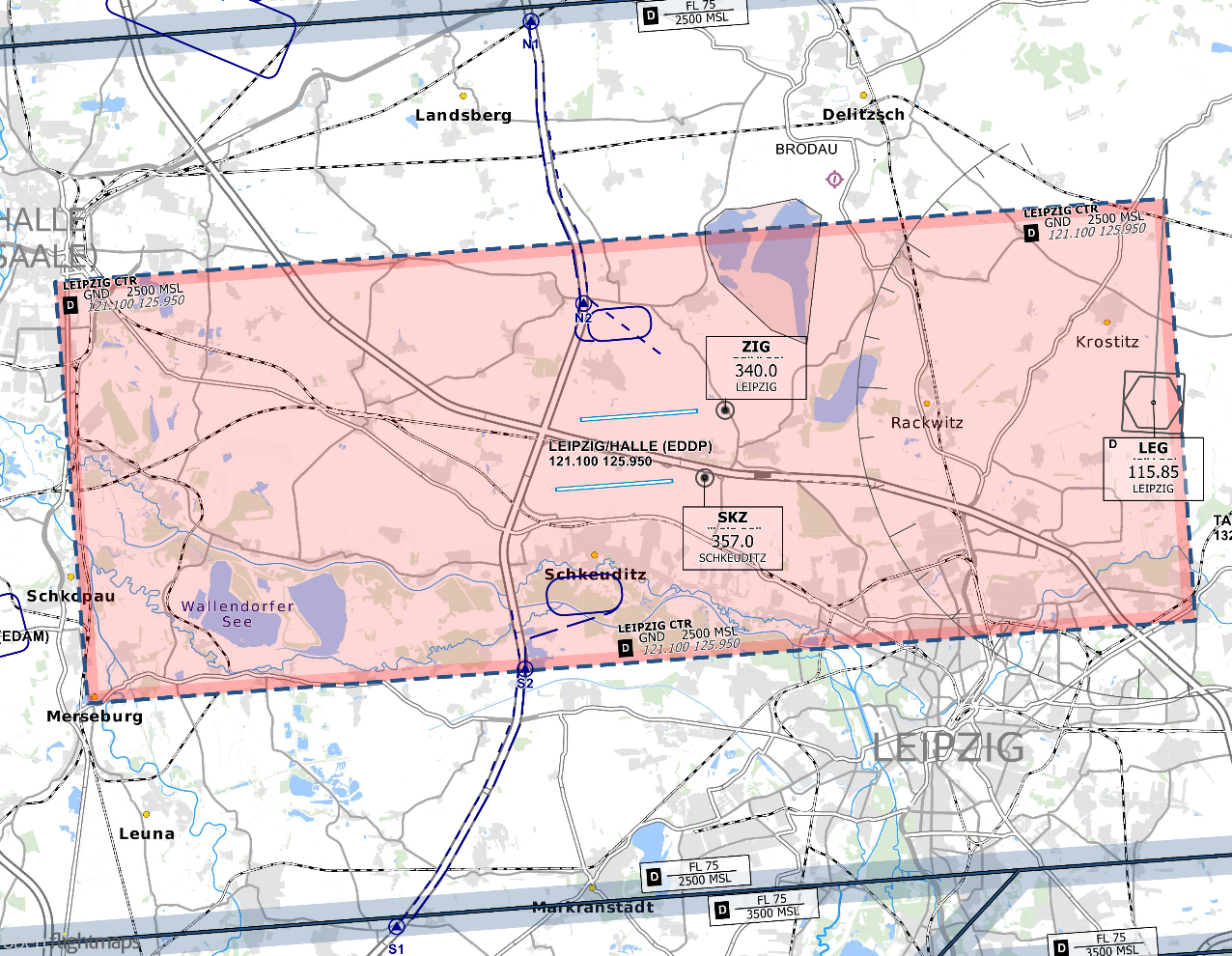](https://knowledgebase.vatsim-germany.org/uploads/images/gallery/2022-09/eddp-ctr.png)*Controllzone Leipzig - © [openflightmaps.org](https://www.openflightmaps.org/)
*
Handovers between the towers should take place between the runways. A transfer point (e. g. circling) would be the tower.
#### High Intensity Runway Operations (HIRO)
Due to the higher traffic volume at night, pilots are expected to vacate the runway between 2200lcl and 0600lcl via the following high-speed taxiways:
| **Aircraft type** | **Runway 08R** | **Runway 26L** |
|---|
| B752 / A306 / B763
ALL MEDIUM (Jet and Prop)
| **S6** (2550m/7382ft) | **S4** (1850m/6070ft) |
Aircraft parked at Apron 4/5 cross taxiway T and shall hold short of V.
### Low Visibility Procedures (LVP)
In Leipzig, the ILS is authorised for all runways up to CATIIIb.
During low-visibility operations, single-use of runway OPS shall be used (egregated parallel operations); individual approaches may deviate from this.
To broadcast the information via ATIS that LVP are active, the ATIS maker URL is supplemented by "&lvp", which appears in the ATIS:
> LOW VISIBILITY PROCEDURES IN OPERATION CAT II AND III AVAILABLE
### Scenery problems
In the flight simulators, there are sometimes differences in the various sceneries compared to the Euroscope ground layout. The biggest problem here is the old southern runway, which is still present in the FSX default scenery. It runs parallel to taxiway N between H1 and H5. Furthermore, the old southern runway minimally intersects the new runway. In such cases, you should assign the north runway to the pilots, as this is displayed correctly in all simulators.
# Arrival - Thüringen Low
### Sectorization
München Radar sectors **Thüringen Low Nord** and **Thüringen Low Süd** (EDDP\_TRN/TRS\_APP) are responsible for all arrivals and departures from/to **Leipzig/Halle (EDDP)** and **Erfurt-Weimar (EDDE)**.
Additionally, the station EDDP\_TRS\_APP covers sector Sachsen Low (SAS), handling all movements at Dresden (EDDC).
Requirement for staffing the sectors is proficient knowledge of the SOPs for airports EDDP, EDDE and EDDC, as top-down service shall be provided at those airports. Besides those controlled airports, the uncontrolled airfield Leipzig-Altenburg (EDAC) lays within the sector, offering IFR procedures and is therefore sorrounded by a RMZ.
It is possible to staff two additional stations within Leipzig TMA for delegating Director tasks to separate stations: Leipzig Arrival Nord/Süd (EDDP\_ND/SD\_APP) which do not hold a sector themselves but receive a full release for traffic being sent to them.
The sector dimensions and divisions for the approach sectors underlying EBG Ost are shown in this chart:
[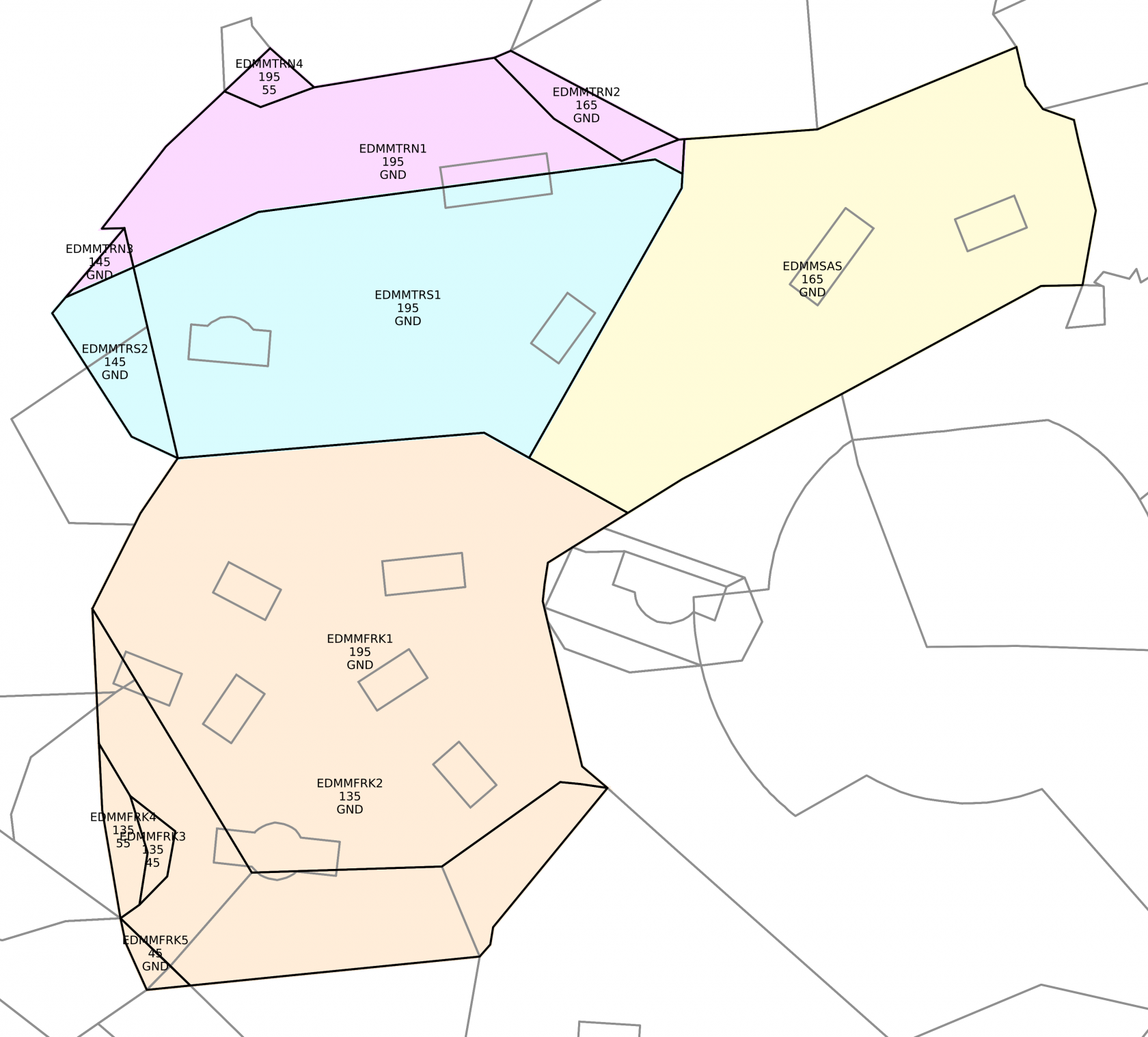](https://knowledgebase.vatsim-germany.org/uploads/images/gallery/2024-12/sectors-edmmost-low.png)
*Approach sectors underlying EBG Ost*
### Airspace
#### Leipzig/Halle (EDDP)
Around Leipzig/Halle, Airspace D (non-CTR) is established up to FL75. Between FL75 and FL100, in the Airspace E band, an additional TMZ is established. VFR traffic is expected to squawk 4404 and monitor 126.175 (EDDP\_TRS\_APP).
Both Airspace D and the TMZ Leipzig consist of always-active parts, and HX parts that are active depending on the operating direction (26 – east active, 08 – west active).
IFR traffic should be kept within protected airspace during daytime. Speed restrictions of Airspace D (≤250 kt) may not be lifted.
[](https://knowledgebase.vatsim-germany.org/uploads/images/gallery/2022-09/eddp-approach-luftraum.png)*Airspace around EDDP. Source: Openflightmaps*
#### Erfurt-Weimar (EDDE)
Erfurt-Weimar is surrounded by Airspace E, and TMZ(HX) Erfurt, activated for IFR traffic on demand. The TMZ code is 4410, and VFR traffic is expected to monitor 126.175 (EDDP\_TRS\_APP).
[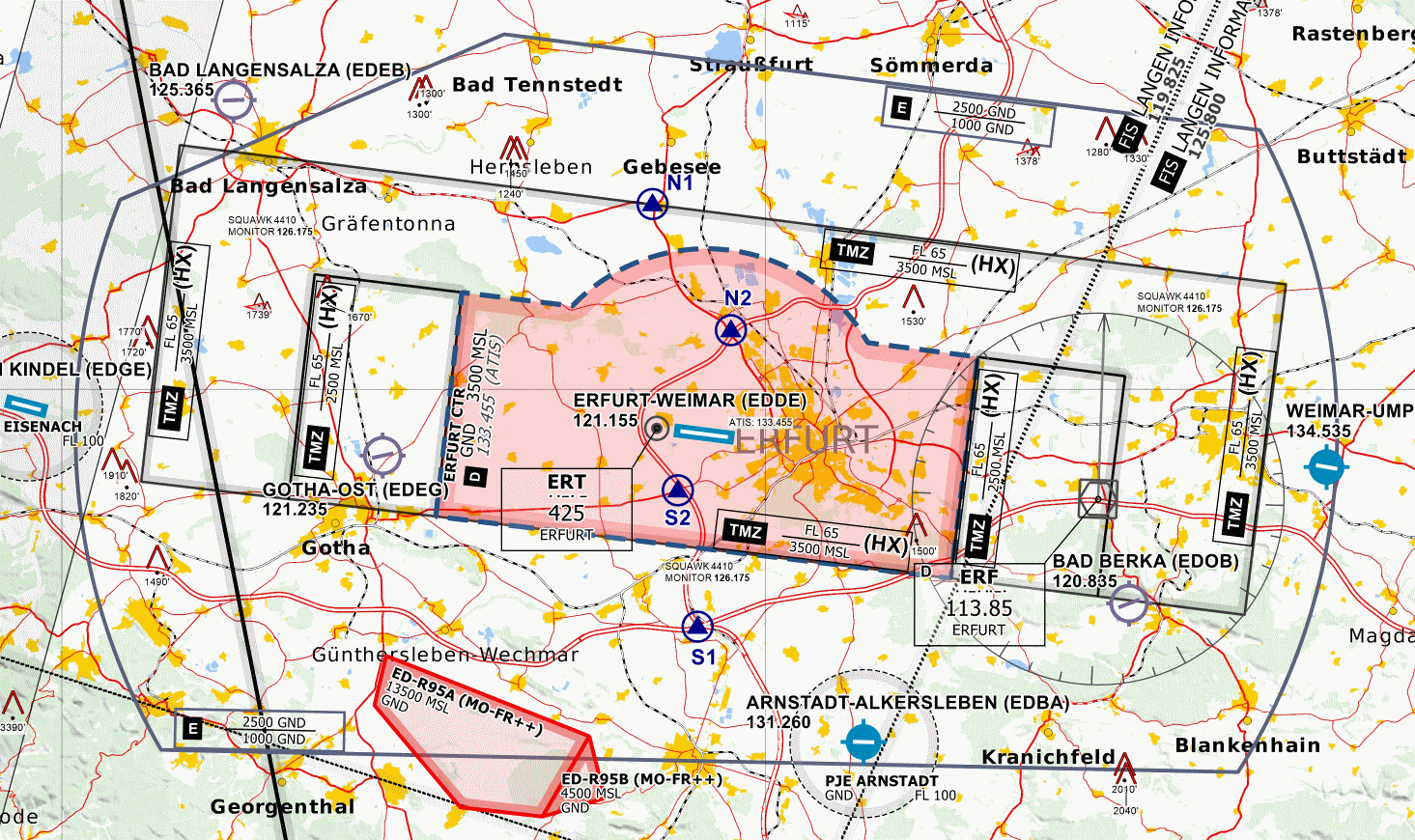](https://knowledgebase.vatsim-germany.org/uploads/images/gallery/2022-09/edde-luftraum.png)*Airspace around EDDE. Source: Openflightmaps*
## Departing traffic
#### Leipzig/Halle
Traffic is handed off to München Radar in their first procedure turn (SID or OID), when proper separation is established.
The speed limit for Airspace D (250 kts) shall not be cancelled.
Departing aircraft may always be cleared to the last waypoint of the SID. Particular attention should be paid to potential conflicts in the Sachsen Low.
#### Erfurt-Weimar
Departures from Erfurt must be coordinated individually with the tower before take-off. The reason for this is the short distance to the sector boundaries of EDGG\_HEF\_CTR and EDDN\_FRK\_APP.
#### Handovers
Thüringen Low hands over departing aircraft from Leipzig as follows:
| **Sektor** | **Wegpunkte** | **Übergabehöhen** |
| **Gera** (EDMM\_GER\_CTR) | NEVKO, GOLAT | FL190 |
| **Halle** (EDMM\_HAL\_CTR) | ORTAG | FL190 |
| **Sachsen Low** (EDDC\_\_SAS\_APP) | DRN | FL150 |
| **Börde** (EDWW\_B\_CTR) | ODLUN, MAG, UMBAL | FL120 |
| **Fläming** (EDWW\_F\_CTR) | RUDAK | FL130 |
The Gera sector and the Meissen sector cover each other in case one of these sectors is not online.
Thüringen Low hands over departing aircraft from Erfurt as follows:
| **Sektor** | **Wegpunkte** | **Übergabehöhen** |
| **Kitzingen** (EDGG\_KTG\_CTR) | ERSIL | FL140 |
| **Franken Low** (EDDN\_FRK\_APP) | BAMKI, TABAT | FL160 |
| **Harz** (EDWW\_R\_CTR) | KUMER | FL180 |
| **Harz** (EDWW\_R\_CTR) | BIRKA | FL200 (released von Halle) |
### Arriving traffic
Arriving traffic comes via the arrival fixes KOJEC, LUXBO, GOXLI and YAWOY. It is important to note that aircraft via ADMOS and BERDI to KOJEC come directly from the Bremen Harz sector (EDWW\_R\_CTR). Aircraft from MAG to KOJEC come directly from the Börde sector (EDWW\_B\_CTR). The same applies to aircraft via LUXBO and YAWOY, which are transferred directly from Meissen (EDMM\_M\_CTR). There are also arrival routes via GOT, which are suitable for non-RNAV aircraft. Here, it is recommended to take aircraft on headings, as the GOT arrivals cross the airport precisely. The speed limit for Airspace D (250 kts) shall not be cancelled; approaching aircraft shall always be guided in protected airspace (TMZ or Airspace C/D).
#### Approach paths
Incoming traffic via KOJEC and GOXLI is **not** cleared for the respective STAR by the centre. This task is performed by the respective arrival station. Incoming aircraft via YAWOY and LUXBO are already cleared for a STAR by Sachsen Low (EDDC\_SAS\_APP). For better planning, aircraft should expect FL110 at KOJEC, LUXBO, GOXLI and YAWOY. The course of the arrival routes is also important, as they conflict with departure routes to the south and north.
[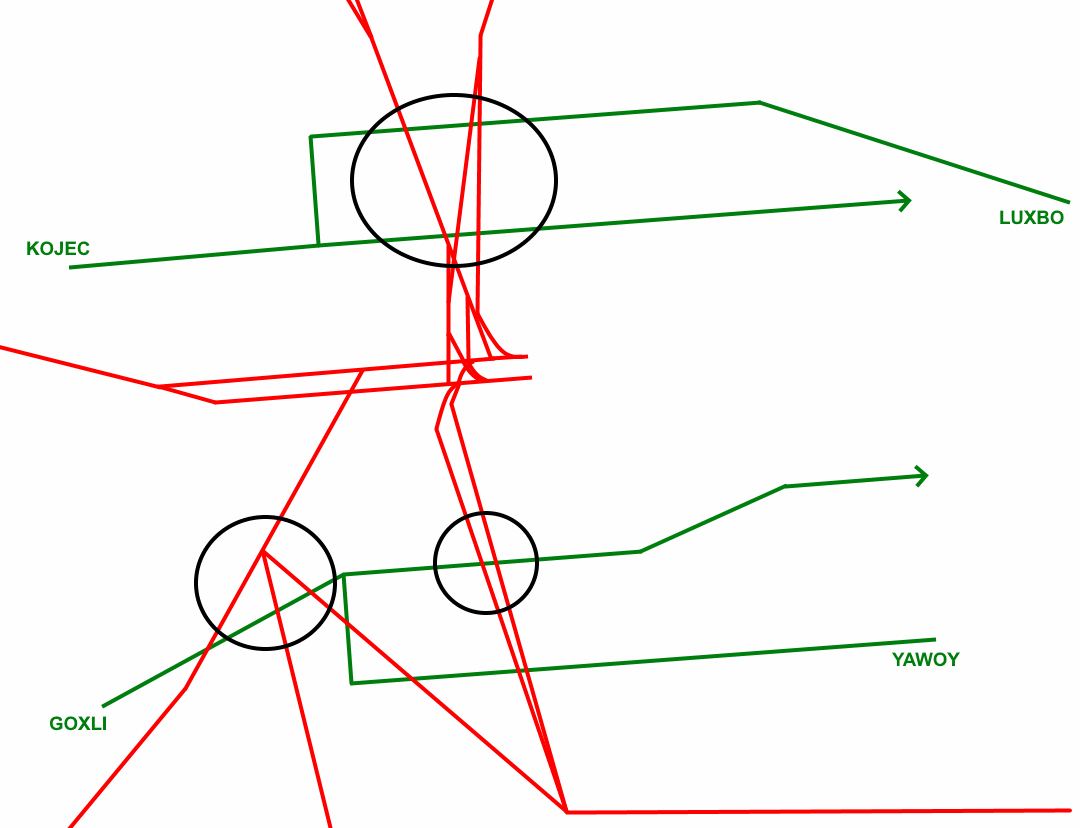](https://knowledgebase.vatsim-germany.org/uploads/images/gallery/2022-09/eddp-konflikte-26.png)Approach paths and conflicts at 26 operations
As can be seen, STARs and SIDs intersect in most cases. It is therefore important to ensure that separation between departing and arriving traffic is maintained at all times. The following altitudes are recommended on the STARs:
| **Position** | **Fluhgöhe** |
| Starting point of the STAR | FL110 |
| Upwind | FL100 |
| Downwind up to airport level | FL080 |
| Downwind from airport level | 5000ft |
It is possible to deviate from these altitudes, but it is important not to clear any aircraft below FL080 before the conflict point between the SID and STAR has been passed. The reason for this is the initial climb from FL070 on all departure routes.
Directs to the respective STAR are may made to waypoints DP424 and DP465.
After the aircraft have flown **past the last waypoint of the STAR**, the pilot is expected to **maintain the downwind track**. In this case, special attention must be paid to the MVA and the boundary to Berlin Arrival, especially during 26 operations. **Entry into this sector without coordination is not permitted**. It is the task of the arrival controllers to keep the downwind as short as possible. In reality, the utilisation of both runways is ensured during peak times.
#### Transitions
Leipzig/Halle Airport has CDA transitions (Continuous Descent Approach), which are available from the waypoints MAXEB, UPLEG and LIPVO. These transitions may only be used between 22:00 and 06:00 local time. However, they are not used very often.
#### Approach types
At Leipzig/Halle Airport, there are three published approach types for all runways. Leipzig has ILS, LOC and RNP approaches. If a visual approach needs to be cleared, the approach controller is obliged to inform the tower controller.
At night, the final approach must be at least at 11 NM for noise protection reasons (26: DP447/DP437, 08: DP442/DP432).
#### Operating mode
Independent parallel approaches are permitted in Leipzig. However, the primary operating mode is staggered. Every controller must familiarise themselves with the conditions of the respective operating mode in advance. Further information is available at the Tower-SOP. It is important to note that despite all conditions for IPA or staggered approaches, the MVA must be observed at all times!
#### Runway assignments
- Aircraft on the KOJEC, LUXBO arrival awaiting the northern runway
- Aircraft on GOXLI, YAWOY arrival awaiting the southern runway
- Aircraft parked on aprons 1 and 3 await the northern runway
- If traffic conditions permit, cargo aircraft land on the southern runway
- The A346/B77W/B744/B748/A388 aircraft types should be assigned to the southern runway
Depending on the traffic situation, deviations from these specifications are possible. However, the arrival determines the runway to be used by the aircraft in all cases. During high-traffic operations, it is recommended to send more aircraft to the northern runway, as the southern runway is heavily congested with departures due to cargo traffic.
#### Handover to arrival
The handover to arrival normally takes place at a speed of 220 kts. *If traffic conditions permit or require, aircraft may also be handed over at a higher or lower speed.*
Traffic on the downwind leg is normally handed over as shown below:
| **Downwind** | **RWY 08** | **RWY 26** |
| **North** | 5000ft | 4000ft |
| **South** | 4000ft | 5000ft |
Individual direct approaches can also be coordinated with the arrival.
#### Two Feeder Operations
Before opening the second arrival position, TRS, TRN and DPSD need to be staffed. The following procedures are necessary for two arrivals:
- Independent parallel approaches **shall** be used
- Independent Parallel Approaches need to fly an **ILS** approach **or**
- an **RNP** Approach **with vertical guidance** (LNAV-only is not authorized, this is desribed on the approach charts as well)
- Intercept headings need to be ≤ 30 degrees to the final approach track.
- 1 NM straight and level on the intercept heading,
- 2 NM straight and level on the final approach course
- The north arrival (F\_APP) receives aircraft for the northern runway
- The south arrival (U\_APP) receives aircraft for the southern runway
- The pickup determines the runway and transfers aircraft to the appropriate feeder
#### Application of RECAT-EU procedures
Leipzig is one of the airports at which the DFS approved the use of the RECAT-EU procedures.
**The use of them is only allowed for the category "Lower Heavy/Upper Heavy" and "Lower Heavy/Lower Heavy", these are the aircraft types: **
| ##### **Upper Heavy**
| ##### **Lower Heavy**
|
| **A330** | **A300** |
| **A340** | **A310** |
| **A350** | **B703** |
| **B747** | **B757** |
| **B777** | **B767** |
| **B787** | **B783** |
| **IL96** | **C135** |
|
| **DC10** |
|
| **DC85** |
|
| **IL76** |
|
| **MD11** |
|
| **TU22** |
|
| **TU95** |
According to the procedure 2 of the above aircraft types only have to be separated 3NM (wake turbulence) unless another method of separation (e.g. radar separation) requires more.
The pilot can refuse this procedure at any time, but shall inform you early.
Caution between Upper-Heavy and Lower-Heavy! The "Lower Heavy" must be preceding!
Mediums are excluded from this procedure!
#### Erfurt-Weimar
Aircraft are guided either via headings or the STAR. Clearance for the STAR is always given from Thüringen Süd Low. Here, particular attention must be paid to the convergence of traffic on the downwind and base legs. In addition, attention must be paid to VFR traffic, as the Erfurt TMZ area is very small and not every pilot is aware of the activity in this airspace. Furthermore, the MVA in Erfurt plays a not insignificant role. As soon as low visibility operations have to be used, approach direction 09 is no longer usable. Only the ILS on 27 up to CAT IIIb is permitted here.
### Overflights
The Thüringen Low sector is also responsible for some overflights due to its vertical boundary of FL195.
Further information can be found in the internal ATCISS.
### Holzdorf
The Holzdorf military airfield has an area of responsibility in which Holzdorf Radar can control aircraft when activated. Berlin Arrival South is obliged to inform München Radar about the activation/deactivation of Holzdorf.
All aircraft to/from Holzdorf must be individually coordinated between Bremen Radar/München Radar and Holzdorf Radar.
[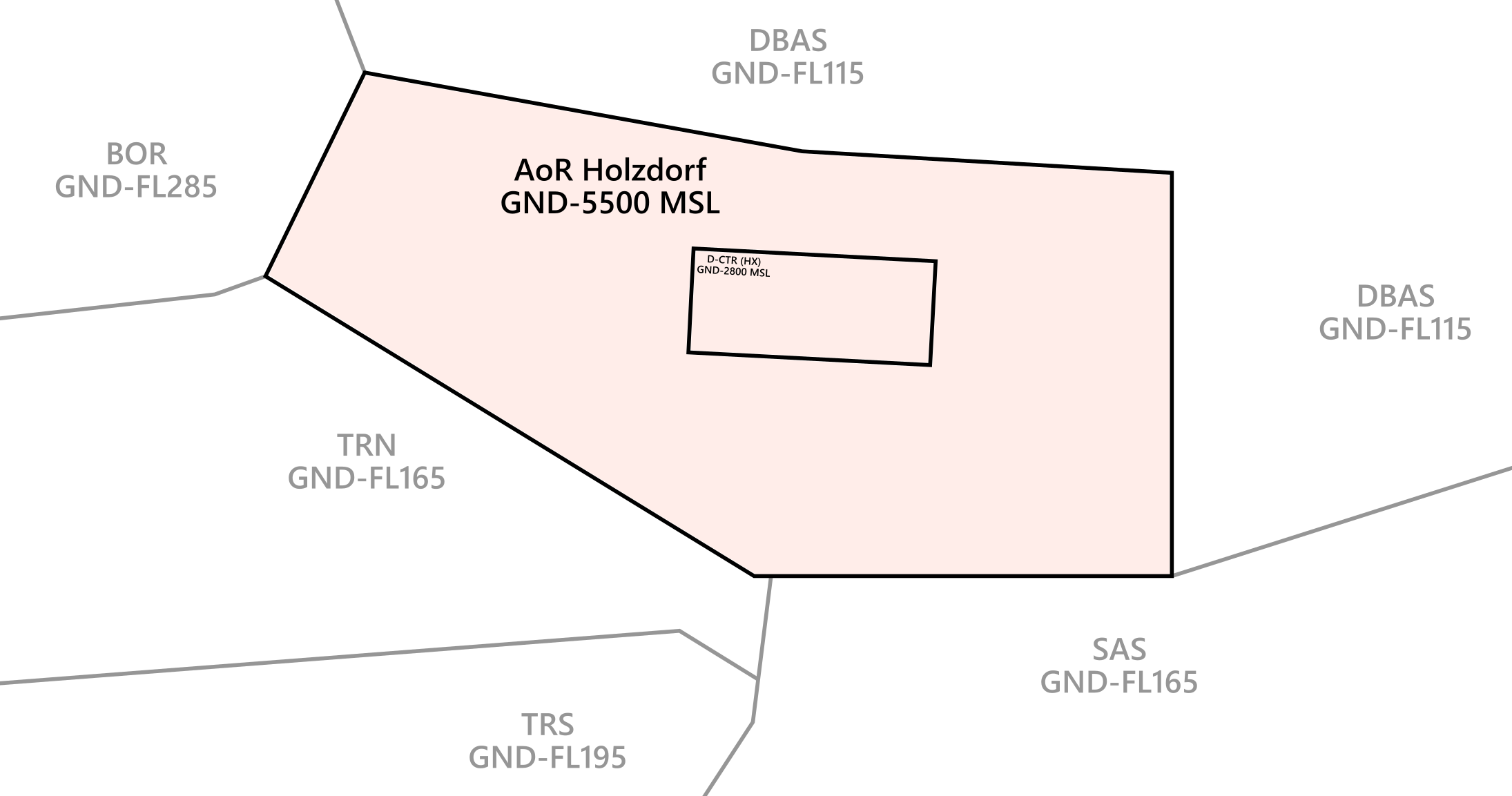](https://knowledgebase.vatsim-germany.org/uploads/images/gallery/2022-10/holzdorf-aor.png)
### Release Areas
#### TORGAU Area
- GND - FL105 (Wenn Holzdorf AoR aktiv: 5500 MSL - FL105)
- Delegation von DBAS an TRN/S
- Only EDDP Inbound RWY 26
Activation only possible upon request from TRN/S by DBAS
#### MULDE A Area
- FL135 - FL165/FL195
- Delegation von TRN/S an ACC Sector FLG
- For EDDB TMA Inbounds (earlier descent possible)
Activation only possible upon request from ACC Sector FLG via TRN/S
#### MULDE B Area
- FL165 - FL195
- Delegation von TRN/S an ACC Sector FLG
- For EDDB TMA Inbounds (earlier descent possible)
Activation only possible upon request from ACC Sector FLG via TRN/S
[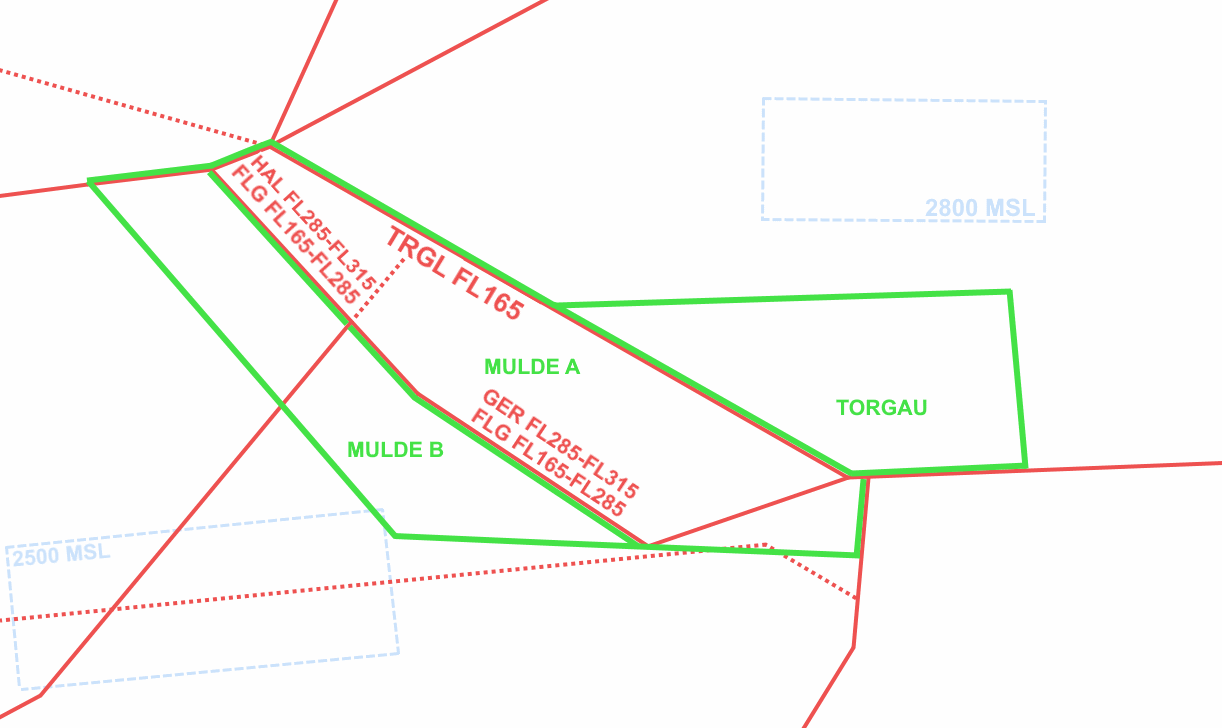](https://knowledgebase.vatsim-germany.org/uploads/images/gallery/2022-09/mulde-torgau-area.png)*MULDE A,B Area, Torgau Area*
# EDDN - Nürnberg Airport
# Overview
### Nürnberg ATC Stations
| **Station**
| **Station ID**
| **Login**
| **Frequency**
| **Remark**
|
| **ATIS**
| NX
| EDDN\_ATIS
| 123.080
|
|
| **Ground**
| NG
| EDDN\_GND
| 121.760
|
|
| **Tower** | NT
| EDDN\_TWR
| 118.305
|
|
| **Radar**
| FRK
| EDDN\_FRK\_APP
| 129.525
| München Radar
Sector Franken Low
|
| **Arrival**
| DND
| EDDN\_D\_APP
| 119.475
| Relief Station
|
### Local agreements
The following agreement always applies:
- If FRK or a radar station covering it are online, publish the departure frequency using the `&depfreq=XXX.XXX` ATIS parameter.
# Ground
Nürnberg Ground is responsible for IFR and start-up clearance as well as all taxiing traffic at the airport.
### Departures
| **SID** | **Initial Climb** | **After Take-Off** | **Remark** |
|---|
| **BOLSI** | 1C | 10 | FL70 | contact
München Radar
129.525 | RNAV1 required. |
| 1G | 28 |
| **ERETO** | 1C | 10 |
| 1G | 28 |
| **RODIS** | 1C | 10 |
| 1G | 28 |
| **SUKAD** | 1C | 10 | RNAV1 required.
|
| 1G | 28 |
| **SULUS** | 1C | 10 | RNAV1 required.
Only available for flights intending to proceed SULUS L604.
|
| 1G | 28 |
| **ERL**
*Erlangen*
| 2C | *10* | *remain with
Nürnberg Tower
118.305* | RNAV1 required.
*For local IFR training flights at EDDN, prop-type aicraft up to 5.7 t MTOW only.
Contact München Radar when advised by Tower.*
|
| 2G | *28* |
| **NUB**
*Nürnberg*
| 1A
| 10 | 6000 ft
| *contact München Radar 129.525
| For non-RNAV1 equipped aircraft only. For RNAV1-equipped aircraft by ATC only. |
| 1B
| 28 |
Departures on SIDs are generally released in Nürnberg, i.e. route clearance can be given without further request. Departures via vectors must be coordinated with the APP controller.
#### Datalink Clearance (PDC/DCL)
Datalink clearances are offered in Nürnberg. The station code is `EDDN`.
### Helicopter
The helipads are within the area of responsibility of the ground. Helicopters are to be handled like normal fixed-wing aircraft, with the exception that the terms hover instead of taxi or air-taxi instead of taxi are to be used for them.
Air-taxi of helicopters are generally prohibited on all apron areas and taxiways with the following exceptions:
- Local rescue helicopters are allowed to use taxiway F for take-offs and landings in operating direction 10 and 28
It can be used for helicopters with a rotor blade of up to 20 m in both directions (usable length 1000 m)
- Air-taxi from/to the helicopter parking areas H1 - H3 can be authorised via taxiway J or taxiway J and M3
- Air-taxi from/to the helicopter parking area H4 can only be performed via taxiway F and taxiway M2.
- on taxiways A, B, C, D, E, F and J
### Limited taxiways
- Taxiways **M1, M2, M3, M4, J, N2 and N4** are available for aircraft up to ICAO Code **Letter C** (wingspan under 36 metres, e.g. B737/A320), up to Code Letter F with Follow-Me (not simulated on Vatsim)
- Taxiway **N2** is to be used exclusively for **incoming traffic for parking positions 30 - 35**
- Taxiway **N4** is to be used exclusively for **incoming traffic for parking positions 40 - 44**
- Aircraft up to ICAO Code **Letter B** (wingspan less than 24 metres) can taxi on all taxiways in the general aviation apron areas (**S3, S4 and T2**)
- Incoming traffic taxiing on taxiway C CANNOT be sent to the right onto taxiway F
### Parking positions
The parking position is normally assigned by the GroundRadarPlugin.
- Positions 01 - 16 and 30 - 35 and 40 - 44 -> facing south
- Positions 26 - 28 and 81 - 86 -> facing north
- Positions 01 - 04 Cargo
- Positions 26 - 28 Heavy
- Callsign ADN (Aerodienst Nürnberg) - The hangar of Aerodienst Nürnberg is located in the southern part of the airport (behind hangars 3 + 4) at apron R9 and can be reached via S3, H
- Callsign IFA (FAI Aviation Group) - The FAI hangar and apron R11 are located east of S4
### De-icing
Aircraft de-icing is always carried out at all parking positions on the main aprons at Nürnberg Airport.
# Tower
### Operating direction
The operating direction is coordinated between TWR and APP. Runway 28 is to be used in preference. The operating direction should only be changed during continuous traffic if a tailwind component of more than 5 KT is otherwise to be expected.
Please note that only runway 28 can be used for low visibility operations.
#### Change of operating direction
- TWR decides on a change of operating direction in consultation with APP and arranges a specific time for this
- Traffic is planned and cleared accordingly on the ground and in the air
- TWR report the last start in the old operating direction to Director and APP
- APP reports the callsigns of the last planned approaches in the old operating direction to the tower
- Director gives a 15NM check to the tower for the first approach in the new operating direction of a runway
### Approaches
Approaches are to be staggered by APP and handed over on the approach base line at 8 NM at the latest
Non-precision approaches, aerodrome circuit approaches or approaches that do not wish to perform a final landing must be coordinated between the APP and TWR.
Visual approaches must be coordinated between TWR and APP. The requirements stipulated in the AIP must be observed; in exceptional cases (e.g. weather, emergencies, ambulance flights, etc.) this may be deviated from.
#### Required separation
APP is responsible for creating and maintaining the separation between approaches.
Speed instructions from TWR for approaches must be coordinated in advance. TWR is then responsible for maintaining the separation.
#### Missed approaches
A missed approach must be coordinated between the APP and TWR. Pilots should primarily follow the published missed approach procedure. In exceptional cases, a "fly runway track, climb to FL70" can also be instructed, which may be appropriate in Nuremberg if there is a lot of traffic.
#### Practice approaches
The published missed approach procedure must not be used for practice approaches with a new take-off/take-off, but a SID must always be assigned.
### Departures
#### Separation obligation
TWR is responsible for establishing and maintaining the separation between two take-offs. The following aircraft may only be released for take-off if the radar separation minimum or the required wake turbulence separation to the preceding aircraft is given at the time of take-off and the separation remains or increases.
#### Intersection Departures
Airliners are always sent to the beginning of the runway. Deviations are possible with the pilot's consent. Pilots of small (VFR) aircraft must expect an intersection departure.
**Intersection C should NOT be used due to inbound traffic. If you using them, advise the arriving traffic to vacate later than C!**
### VFR traffic
VFR arrivals and departures may enter or leave the control zone at a maximum of 3,000 ft AMSL. Circuits to the south should be avoided for noise protection reasons.
#### Helicopter take-offs and landings
Taxiway F can be used for take-offs and landings. The decision lies with the tower, the pilot must report if he cannot accept this. In most cases, however, these departures are carried out as intersection takeoffs from taxiway J.
#### Take-offs and landings of DRF rescue helicopters
The following procedures are to be observed when carrying out operational flights by the local DRF rescue helicopters (CHX27 and CHX88).
CHX27 must be assigned the discrete transponder code 7027.
CHX88 must be assigned the group code 0020 for rescue flights.
In order to avoid having to keep the entire TWY free when using the above procedure for departures from TWY F, the following procedure was agreed with the DRF (only for CHX27 and CHX88):
An artificial landing zone will be set up, which must be kept clear during take-offs and landings of the two rescue helicopters, extending westwards to the junction of TWY J and eastwards to the eastern boundary of the hoverway.
TWY C can therefore be used freely without further restrictions, provided that traffic information is provided on all aircraft involved.
Aircraft on TWY D must be clear of TWY F for the application of the procedure.
TWY F can only be used to the east as far as apron G3.
[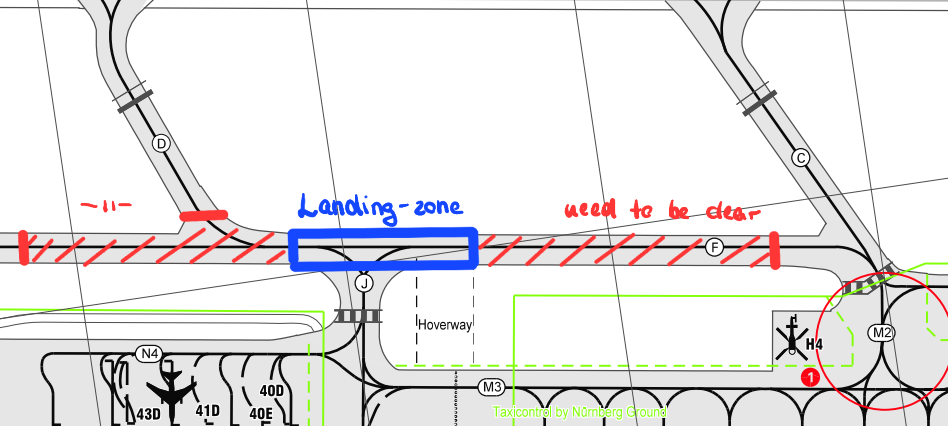](https://knowledgebase.vatsim-germany.org/uploads/images/gallery/2024-03/screenshot-2024-03-08-145849-1.png)
AD2 EDDN 2-7 - With the kind permission of DFS Deutsche Flugsicherung GmbH. Not suitable for navigational purposes.
# Arrival - Franken Low
The Nürnberg sector does not cover a pure approach sector, but the fully-fledged lower sector Franken Low (FRKL) in the GND - FL195 level band. In addition to arrivals and departures to/from Nuremberg, a few transits cross the sector. Franken Low is also home to the controlled aerodrome Hof-Plauen (EDQM), as well as numerous info airports with a RMZ and IFR procedures. The exact structure of the sector can be seen in the following sector chart.
[](https://knowledgebase.vatsim-germany.org/uploads/images/gallery/2022-11/sectors-edmmost-low.png)
### Arrivals
#### RNAV Arrivals
The arrivals in Nürnberg have their clearance limit at the corresponding transition fix (see table) and must already be filed by the pilot in the flight plan, but explicitly cleared. Pilots must at least be BRNAV-equipped, for NON-RNAV a route must be filed according to ERL or NUB.
| **Waypoint
Designator**
| **RWY** | **CL Holding
(MHA 5000ft)** | **Remarks** |
| **DODAS**
| 1T | 10 | left, 170°
|
|
| 1V | 28 | not to be used during activity of NLFS |
| **PIVIR** | 1T | 10 | right, 204°
|
|
| 1V | 28 | not to be used during activity of NLFS |
| **LETKU** | 1T | 10 | left, 042° |
|
| 1V | 28 |
|
| **UPALA** | 1T | 10 | right, 315° |
|
| 1V | 28 | |
#### Approach procedure
In operating direction 28, Nürnberg has a CAT IIIb-certified ILS, as well as one RNAV and two published LOC approaches (LOC Z and LOC Y) and thus logically another localiser antenna in addition to the LOC antenna belonging to the full ILS. In operating direction 10, Nürnberg has a CAT I-certified ILS, as well as an RNAV and VOR approach.
Visual approaches may be cleared after coordination with the tower, but must be conducted in such a way that the final approach for RWY 28 approaches from the north is at least 2.5 NM (5 DME NUB), for approaches from the south the final approach is at least 5.5 NM (8 DME NUB) and for RWY 10 the final approach is at least 5 NM (4 DME NUB).
#### Working with the arrival position
In reality, there is no longer a arrival in Nuremberg, but due to the unrealistically high flight movements on Nuremberg Monday, this station has been retained on VATSIM.
The handover between FRKL and ARR takes place at 28 operation downwind sinking to 6000ft, at 10 operation sinking to 5000ft.
#### Target separation on final
There is no target separation per se and all pilots are requested to separate according to the traffic conditions on the final. Requests for separation from TWR must be implemented within 10 minutes, speed requests from TWR immediately.
With a balanced traffic flow, a separation of approx. 6 NM is usually suitable to utilise the runway as efficiently as possible. Higher separation minima due to wake vortices or similar must of course be given priority!
### Departures
#### Handoffs
With the exception of ERL departures, departures in Nuremberg are obliged to make an initiation call on the corresponding departure frequency immediately after take-off.
#### Local IFR via ERL
For local IFR flights, the tower must always plan via ERL; unlike all other SIDs, the tower keeps departures via the ERL departure on frequency until they have left its AoR or there is a separation to traffic in the control zone.
### Agreements
see [ATCISS](https://atciss.vatsim-germany.org/loa).
# EDDC - Dresden Airport
# Overview
Dresden can be staffed up to TWR as S1 within the framework of the S1 Minor Program of FIR Munich.
### Dresden ATC Stations
| **Station**
| **Frequency**
| **Login**
| **Station ID**
| **Remark**
|
| **ATIS**
| 118.880
| EDDC\_ATIS
| CX
| --
|
| **Ground**
| 121.980
| EDDC\_GND
| CG
| to be opened **only after** Tower is staffed |
| **Apron**
| 121.755
| EDDC\_A\_GND
| CP
| **event only:** not to be staffed unless part of a rostered event |
| **Tower**
| 122.930
| EDDC\_TWR
| CT
| **primary**
|
| **Sector Sachsen Low**
**(Radar)**
| 125.875
| EDDC\_SAS\_APP
| SAS
| covered by TRS if not staffed
|
# Ground
### Responsibilities
Also check the information for [Dresden Apron](https://knowledgebase.vatsim-germany.org/books/sops-fir-munchen/page/apron-Jam "Apron"), as Ground will cover the position unless it is separately rostered.
Dresden Ground is responsible for issuing enroute and startup clearance for departing traffic. Additionally, Dresden Ground is responsible for ground movement control within the maneuvering area. Dresden Ground shall only be opened if Dresden Tower is already staffed.
#### Datalink Clearance (PDC/DCL)
Datalink clearances are **not** available in Dresden.
#### SID Assignment
**Normally, a standard SID shall be assigned** according to the runway direction decided by Dresden Tower. During times of low traffic and suitable wind conditions, SIDs for the most efficient runway direction may be assigned (e.g. flight via KOBUS off RWY04 while main operating direction is 22). **This shall only be done after individual coordination with Tower and Arrival Sector Sachsen Low**.
- OSKANxW departure shall only be assigned **after approval** from Arrival Sector Sachsen Low.
- Visual Departures **may be approved** for aircraft of wake turbulance category **LIGHT and MEDIUM**.
#### Ground Movement Control
The AoR of Dresden ground **are all taxiways except those marked below**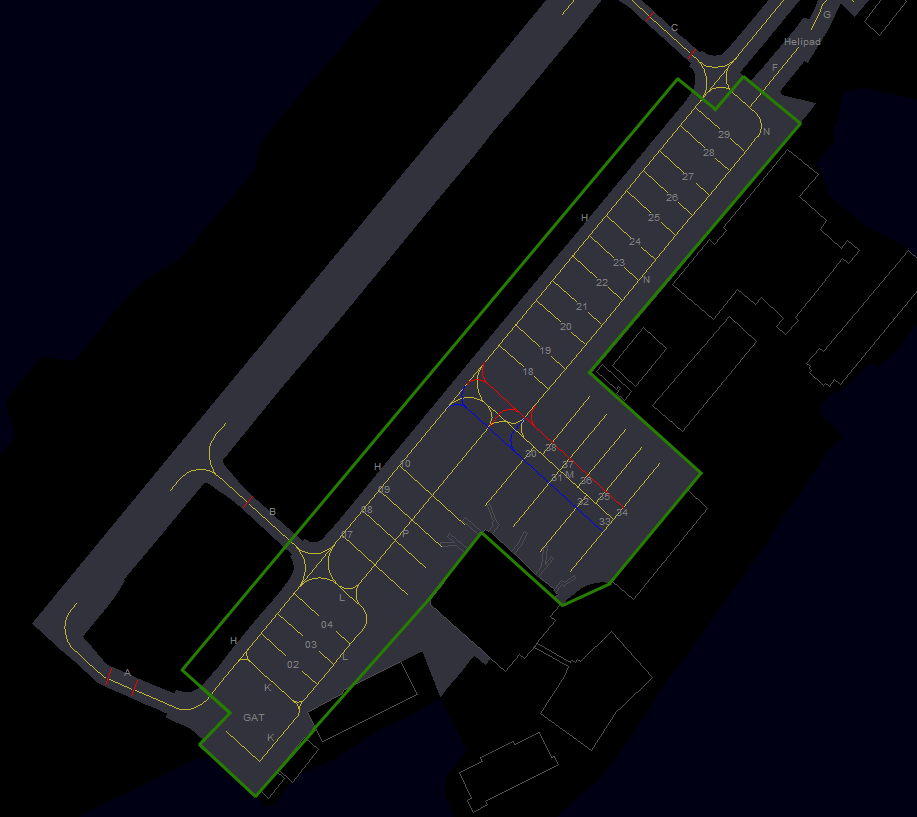](https://knowledgebase.vatsim-germany.org/uploads/images/gallery/2022-09/eddc-apron.png)
#### Arriving Traffic
shall be handed off to Dresden Apron as folllows:
- Traffic via D/E, H shall be handed off holding short of TWY C
- Traffic via C shall be handed off holding short of TWY H
- Traffic via A/B shall be handed off holding short of TWY H
##### Departing traffic
will be handed off from Dresden Apron as follows:
- Traffic via A will be handed off holding short of TWY A
- Traffic via C/D/E will be handed off holding short of TWY C
- Traffic via B will be handed off holding short of TWY B
##### Low Visibility Procedures (LVP)
During low visibility procedures, intersection departures shall not be approved and the full runway length must be used.
# Apron
**Dresden Apron is not to be used!**
Apron can only be opened for events with a staffing plan. The tasks are taken over by Dresden Ground.
Dresden Apron is a ground position responsible for all rolling traffic on the apron. After consultation with Ground, taxi clearances can also be given up to the holding point. Furthermore, this station is responsible for clearing pushbacks.
### AoR
Dresden Apron is responsible for all aircraft movements on the apron. This means that taxiways M, K, L, P, N, and H (between A and C) also fall within the apron control area's jurisdiction.
[](https://knowledgebase.vatsim-germany.org/uploads/images/gallery/2022-09/eddc-apron.png)*AoR*
## Taxi instructions
Departing traffic
- During 04 operations: Aircraft are sent to taxiway A or B (transfer to the tower).
- During 22 operations: Aircraft are sent via taxiway H to intersection C or N (transfer to ground).
Incoming traffic
- During 04 operations: Aircraft arrive on taxiway H (waiting at taxiway C) from ground control.
- During 22 operations: Aircraft arrive on taxiway A or B directly from the tower.
### Specials
**Taxiway P**
Taxiway P can be used for pushbacks of aircraft at positions 7-10. Aircraft can still taxi on taxiway H during this process.
**Taxiway M**
Taxiway M has a yellow, orange, and blue line. Between sunrise and sunset, aircraft with a maximum wingspan of 36 m can taxi alongside each other on the blue and orange lines. In addition, this procedure may only be used if the RVR is greater than 350 m. Aircraft are not permitted to taxi simultaneously on the yellow and orange/blue lines.
**Stands 18-29**
These parking spaces are known as taxi-out stands. They are accessed via taxiway N and exited via taxiway H.
#### Restrictions
- **Taxiway C**
- Maximum wingspan 20 m
- **Taxyways K, L (zwischen Stand 2 und K)**
- Maximum wingspan 24 m
- **Taxyways M (blau, orange), L, N, P**
- Maximum wingspan 36 m
- **Tayxyways F, G**
- Only for helicopters
#### Low Visibility Procedures (LVP)
During low visibility procedures, intersection departures shall not be approved and the full runway length must be used.
### Parking positions
- Gates are assigned as needed.
- The GAT for sports aircraft is located at taxiway K.
- The GAT for business jets is located at parking positions 25-29.
- Apron 5 is used only by helicopters. The Christoph 39 rescue helicopter and the Sachsen police are also stationed here.
# Tower
Dresden Tower is responsible for the runway and traffic within the Dresden CTR.
Also **check the ARR SOP** to familiarize yourself with arrival procedures relevant for tower operations to enable the necessary coordination with Sachsen.
### Control zone
The Dresden control zone extends approximately north of the city of Dresden. The vertical boundary of the CTR is 2500 ft MSL. Entries into and exits from the control zone are made via the mandatory reporting points:
- **West:** November, Mike, Charlie
- **East:** Echo, Tango
[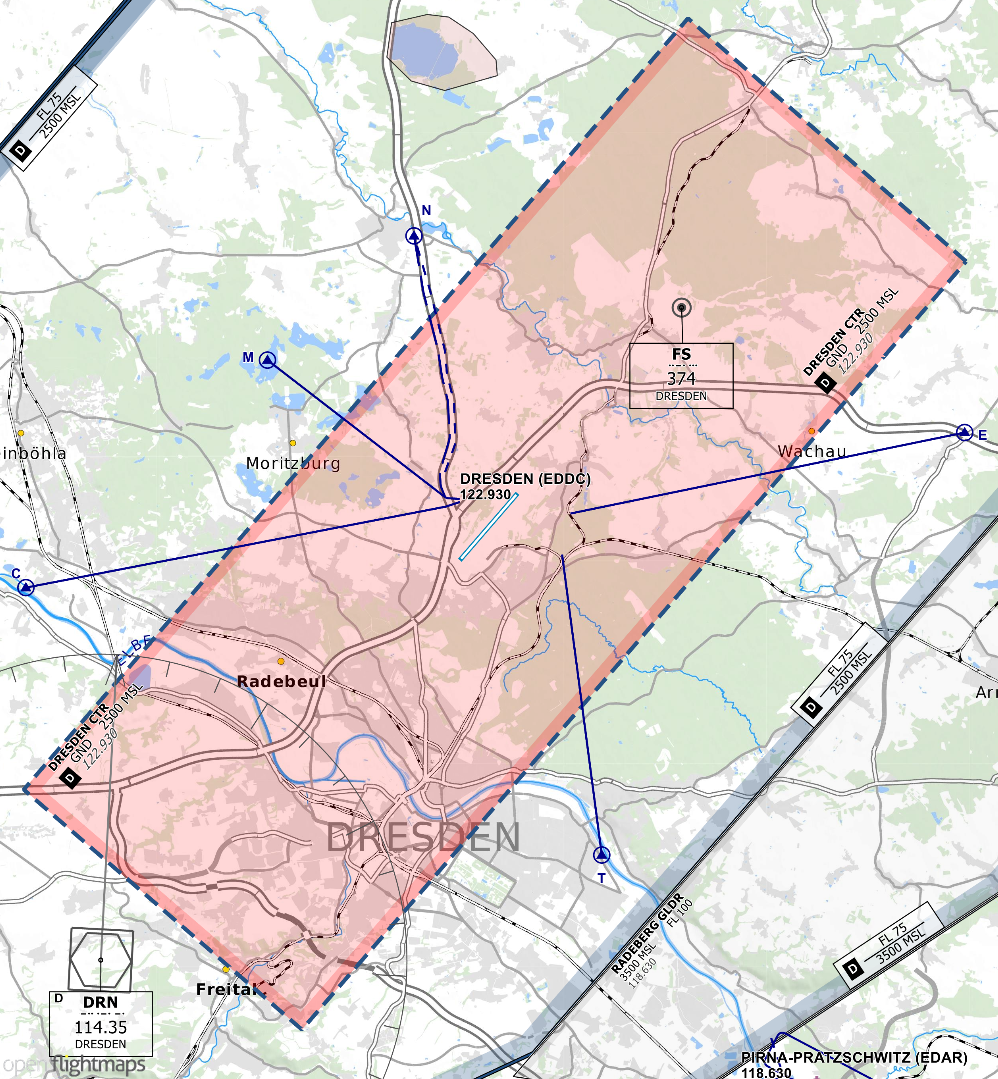](https://knowledgebase.vatsim-germany.org/uploads/images/gallery/2022-09/eddc-ctr.png)*CTR Dresden - © [openflightmaps.org](https://www.openflightmaps.org/)*
## Arriving traffic
Dresden Tower is responsibil for the runway. As the pilot leaves the runway, the tower transfers the pilots to the apron frequency at A, B, and C, and to the ground frequency at D and E.
- Generally, the responsibility for separation of flights subject to separation in CTR Dresden (Airspace D) lies with Tower.
- The responsibility for separation of IFR-Arrivals on Final (not Visual Approach) lies with Sachsen.
After Transfer of Communication, Dresden Tower shall monitor separation and (if necessary) shall take appropriate measures to maintain separation. Suitable measures are for example speed reductions (requires coordination with Sachsen) or GA procedures.
#### Opposite landings
Sachsen may request that aircraft be allowed to land against the direction of operation in order to shorten flight and taxiing times. Departing traffic and VFR traffic may object to this, idividual coordination and consulting are helpful.
If this occurs, all taxiways must be kept clear to the runway!
#### Low visibility procedures (LVP)
Dresden Airport has CAT III only on runway 22. This means that runway 22 must be used for low visibility procedures. In addition, pilots always leave the runway at the end via taxiway A.
## Departing traffic
### Auto-Handoff
Dresend utilizes an auto-handoff procedure for IFR departures where t**ower will not hand off outbounds to the approach controller**. Make sure to set the correct departure frequency in the ATIS.
Outbounds should contact APP **immediately when airborne** unless explicitly told to remain on tower frequency.
#### Opposite departures
Departures against the current operating direction always require a departure release by Sachsen (EDDC\_SAS\_APP), if online, and otherwise by Thüringen (EDDP\_TRS\_APP). A rule of thumb for when such a release can usually be expected is when the next inbound is at least 20 NM from touchdown.
# Radar - Sachsen Low
EDDP\_TRS\_APP covers EDDC\_SAS\_APP when offline.
Also **read the ground and tower SOPs** to familiarize yourself with relevant procedures/operations to enable the necessary coordination.
## Dresden
München Radar Sector Sachsen Low (EDDC\_SAS\_APP) is responsible for all arrivals and departures to/from Dresden (EDDC). Furthermore, Bautzen Airport (EDAB) is located within this sector, which is operating IFR procedures and therefore also owns an RMZ.
The lateral and vertical extent of the sector and the neighboring stations are shown in the following graphic.
[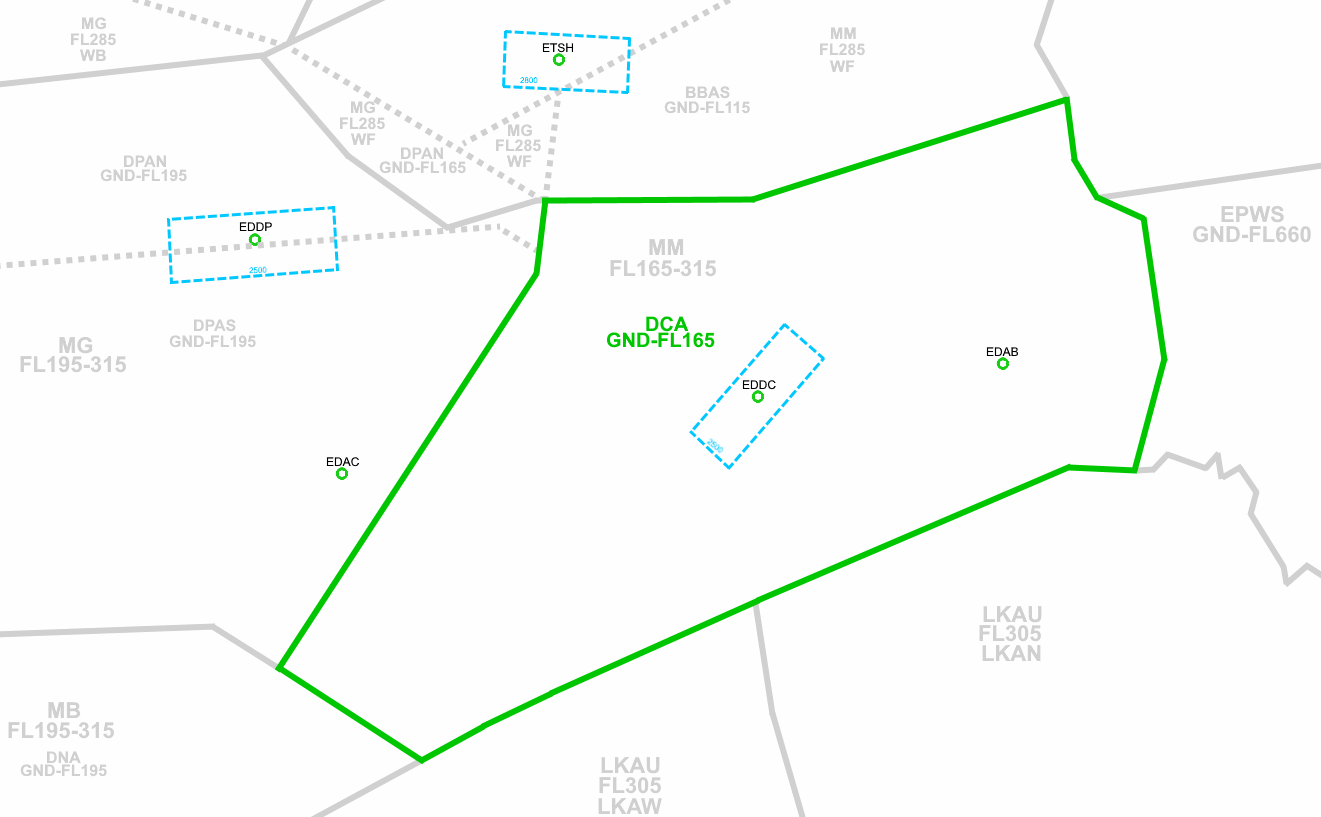](https://knowledgebase.vatsim-germany.org/uploads/images/gallery/2022-09/sachsen-low.png)*München radar sektor Sachsen-Low*
### Airspace
There is a **Delta airspace (non-CTR)** around Dresden Airport, which is divided into different sectors.
The upper limit is FL75. This means that between delta airspace and Charlie airspace, which begins at FL100, there is another echo airspace so that VFR traffic can overfly the airport in high altitudes.
In order to protect IFR traffic, a **TMZ has been established around Delta airspace**. This means that VFR traffic in this “echo band” must independently enter a squawk (**4410**) and establish listening on the frequency. **The air traffic controller does not need to be called.** This listening squawk lets the air traffic controller know that the pilot is listening and allows them to contact the pilot if necessary.
[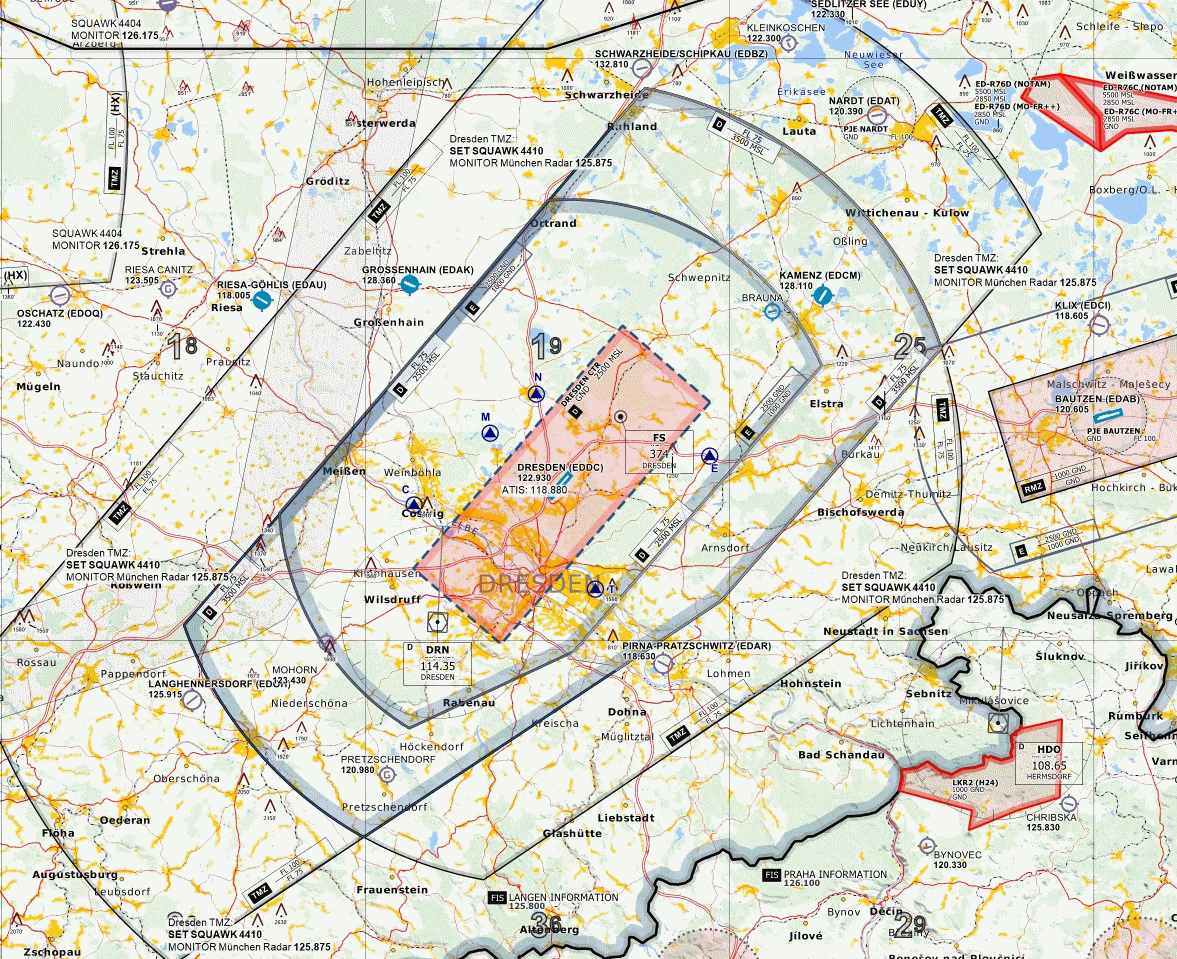](https://knowledgebase.vatsim-germany.org/uploads/images/gallery/2022-09/eddc-approach-luftraum.png)*Airspace D around EDDC*
### Arriving traffic
Incoming traffic arrives via the arrival fixes KOBUS, ABKIS, RIVSA, and GARKI. There are also approaches via DRN and OSKAN, which are suitable for non-RNAV aircraft. They are not recommended, they cross the airport precisely.
#### STAR´s and approaches
Incoming traffic is cleared for the **STAR by center**. They are usually not required and therefore they should not be flown.
Dresden is equipped with ILS, LOC, RNAV, and VOR approaches.
If a visual approach is given, the tower controller must be informed. The intercept on runway 22 must be at 3000 ft and on runway 04 at 4000 ft.
**Runway 22 shall be used for low visibility procedures.** Runway 04 does not have a CAT3 approach.
### Opposite arrivals
It is possible that pilots may request the opposite runway direction in order to shorten flight and taxiing times. In this case, the tower must be asked if the current traffic situation allows it. Wind and other arrivals and departures must be taken into consideration.
##### For all approaches that deviate from standard procedures, special attention must be paid to the MVA.
####
## Other traffic
Dresden is **responsible for approaches** **to** EDQ\*, ETIC, EDAC, and **EDDP**! Transfer LVLs can be found in the LOA.
**For EDDP arrivlas: SAS shall issue the inbound clearance for STARs LUXBO and YAWOY.** Transfer LVL can be found in the LoA.
### Bautzen
Bautzen is surrounded by airspace E from 1,000 feet to FL100 and has an RNP approach to runway 25, as well as SID departures to BUSIR and ABLOX on both sides. The airport is not controlled but has an information.
### Holzdorf
The Holzdorf military airfield has an area of responsibility in which Holzdorf Radar can control aircraft when activated. Berlin Arrival South is obliged to inform München Radar about the activation/deactivation of Holzdorf.
All aircraft to/from Holzdorf must be coordinated individually between Bremen Radar/München Radar and Holzdorf Radar.
[](https://knowledgebase.vatsim-germany.org/uploads/images/gallery/2022-10/holzdorf-aor.png)
# EDJA - Memmingen Airport
# Overview
### Memmingen ATC Stations
| **Station**
| **Station ID**
| **Login**
| **Frequency**
| **Remark**
|
| **ATIS**
| JAX
| EDJA\_ATIS
| 118.855
| --
|
| **Ground** | JAG
| EDJA\_GND
| 121.680
| --
|
| **Tower** | JAT
| EDJA\_TWR
| 126.855
| --
|
| **Muenchen Radar**
(Sektor Iller)
| ILR
| EDJA\_ILR\_APP
| 129.450
| --
|
# Ground
Memmingen Ground is responsible for the start-up and enroute clearance of IFR departures, for which no coordination with München Radar is required. VFR traffic does not require a start-up clearance. Ground is also responsible for taxi control.
### IFR departures
#### Datalink Clearance (PDC/DCL)
Datalink clearances are **not** available in Memmingen.
#### SID assignment
Memmingen has published IFR departure procedures in both operating directions
| **SID** | **Initial Climb** | **After Departure** | **Remark** |
| **KPT**
*Kempten*
| 4B | 06 | FL70 | contact
München Radar
129.450 | RNAV-1 or RNP-1 or A-RNP equivalent. GPS required. |
| 4A | 24 |
| **LUPOL** | 5B | 06 |
| 5A | 24 |
| **UMTEX** | 2B | 06 |
| 1A | 24 |
| **ALG**
*Allgäu*
| 1U | 06 | For non RNAV-1 equipped ACFT, training FLTS or by ATC only. |
| 1T | 24 |
### Ground operation
#### General
EDJA is a former air force base that has been converted for civilian use. This can be seen from the fact that all taxiways are narrower than the ICAO standard and many of them are closed due to a lack of demand and renovation. More attention must be paid than at other airports to ensure that pilots do not inadvertently taxi onto closed areas and taxiways.
#### Restrictions on taxiways
Taxiways "S" and "P" are restricted to aircraft with a maximum outer main gear wheel span of 6 metres. This means that they cannot be used by conventional commercial aircraft, at most by smaller business jets and GA aircraft.
#### Aprons and terminals
The passenger terminal is located on Apron 1 (Stands 1 & 2). Further parking spaces for airliners are located on Apron 2. Apron 3 south of the runway serves as GA parking, where the GAT is also located (only accessible for small aircraft due to the restriction of TWY P).
Pushback is only necessary from the stands at Terminal 1 (Stands 1 and 2) and Stand 6, all other stands are "taxi-in/out".
# Tower
Memmingen Tower is responsible for aerodrome control at Memmingen Airport. Memmingen has a D-CTR.
### IFR departures
Departures are switching immidiately when airborn to radar, the frequenzy shall be in the ATIS. IFR departures via the same SID are to be handed over with 5 NM or (if higher) wake turbulence separation. The Tower is responsible for separation between IFR departures and IFR approaches on a missed approach procedure until the transfer of communications of all flights involved.
### IFR arrivals
IFR approaches are handed over to Memmingen Tower by München Radar using one of the published approach procedures, taking into account radar or (if required) wake turbulence separation. München Radar is responsible for the separation, speed assignments from the tower are not permitted without coordination with München Radar.
#### IFR visual approaches
No special requirements. München Radar may only clear IFR visual approaches after coordination with Memmingen Tower.
### Use of runway
Due to the restriction of TWY "S" and "P", larger aircraft/airliners can only use TWYs "W" and "N". For this reason, landings on runway 06 and take-offs on 24 backtracks are necessary. There are no turnaround pads, the aircraft must turn on the runway.
The formerly offset threshold of runway 06 has been removed, the area to the west of junction W has been declared a stopway and cannot be used for take-off runs.
Intersection takeoffs are permitted:
- **Runway 06:** via C, D, N, S
- **Runway 24:** via C, D, E, N, S
[](https://knowledgebase.vatsim-germany.org/uploads/images/gallery/2022-11/2022-11-28-10-09-17-aip-ifr-germany-mozilla-firefox.png)
### Low visibility procedures
Experience shows that minima problems occur more frequently in Memmingen due to low cloud cover than due to fog (due to the location of the aerodrome on a mountain ridge).
- ILS Cat I (DH 200 ft / RVR 550 m) are available on both runways.
- Low Visibility Takeoffs (LVTO) up to RVR 75 m are permitted on both runways.
- The preparation phase for Low Visibility Procedures begins as soon as RVR <1000m.
- LVP come into force as soon as RVR <600m.
- For RVR <400m LVTO conditions apply (see below)
- Flight operations are no longer possible at RVR <75m.
- LVP end as soon as the RVR exceeds 600m.
Under LVP, intersection takeoffs are not permitted. Under LVTO conditions, only one aircraft at a time may move within the area of responsibility of air traffic control (i.e. on all TWYs and the RWY).
As the ILS only allow Cat I, but LVTO is permitted, this means that at RVR between 75 - 550m it is only possible to take off, but not to land.
Deicing is carried out at the stand.
### VFR traffic
The D-CTR is surrounded by airspace E/G with only one TMZ as an additional protected area.
For noise abatement reasons, the southern traffic circuit shall preferably be used.
[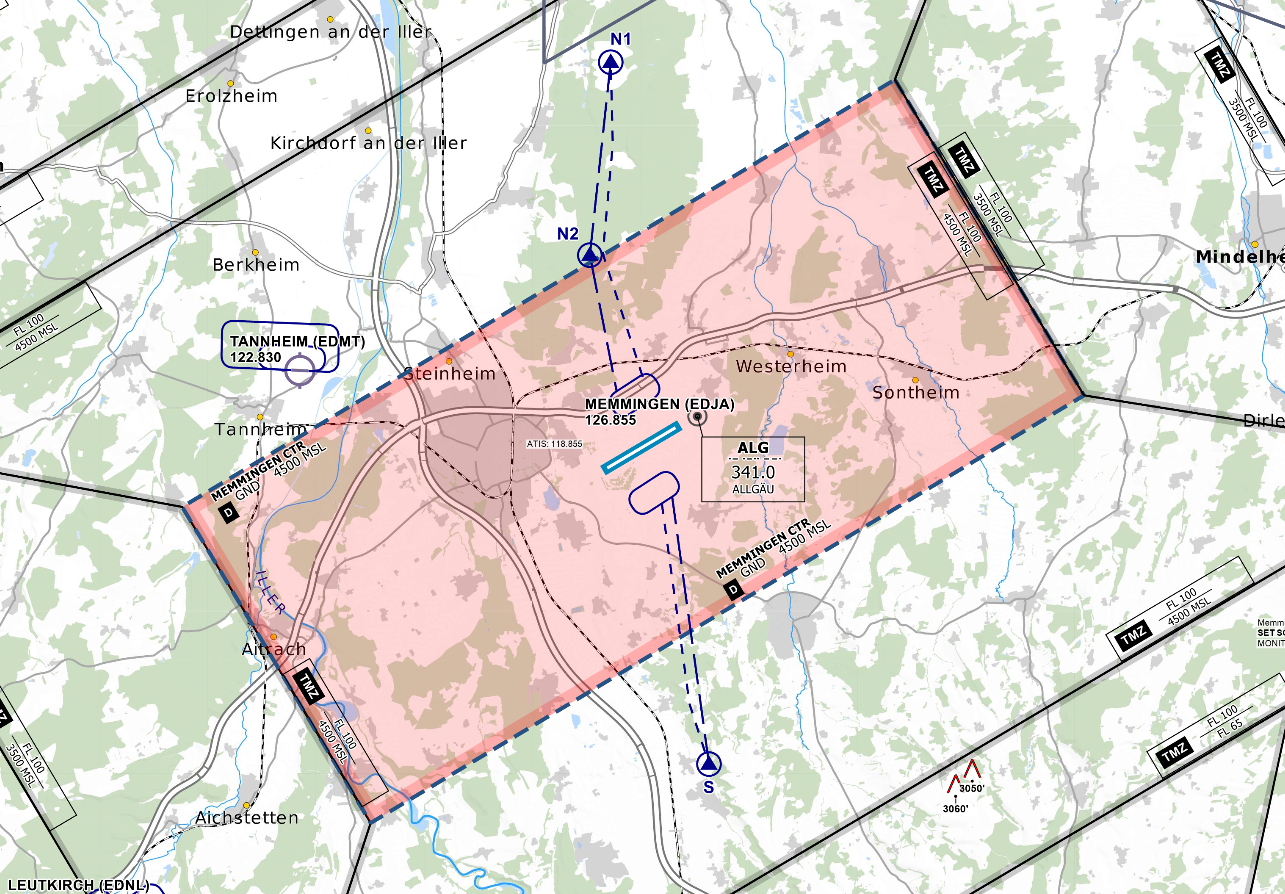](https://knowledgebase.vatsim-germany.org/uploads/images/gallery/2022-11/2022-11-28-09-48-21-mozilla-firefox.png)
### Helicopters
There is no helipad. Helicopters use the runway.
# EDDE - Erfurt Airport
# Overview
### Erfurt ATC Stations
| **Station**
| **Frequency**
| **Login**
| **SI**
| **Remark** |
| **ATIS**
| 133.455
| EDDE\_ATIS
| ADE
| --
|
| **Ground**
| 121.755
| EDDE\_GND
| DEG
| secondary |
| ***Apron*** | *121.905*
| *EDDE\_A\_GND*
| *DEA*
| *event only*
|
| **Tower** | 121.155
| EDDE\_TWR
| DET
| **primary** |
| **Thüringen Low Süd**
(Radar)
| 126.175
| EDDP\_TRS\_APP
| TRS
| --
|
# Ground
Also check the information for [Erfurt Apron](https://knowledgebase.vatsim-germany.org/books/sops-fir-munchen/page/apron-KiQ "Apron"), as Ground will cover the position unless it is separately rostered.
Erfurt Ground is responsible for all taxiing traffic on the taxiways outside the apron. After consultation with Erfurt Apron, the task of taxi clearances can also be taken over by Apron. Erfurt Ground is always reponsible for issuing enroute clerances.
### Runway allocation
Normally, the runway specified by the tower is assigned to the pilots. After consultation with Erfurt Tower (EDDE\_TWR) and München Radar (EDDP\_TRS\_APP), individual deviations from the active runway direction are possible.
### SID assignment
- All departure routes have speed and altitude restrictions (except PILAM #D)
- Initial Climb on all SIDs FL070
- All SIDs require RNAV-1, RNP-1 or A-RNP, as well as GPS equipment
- Aircraft that do not have this equipment fly via the ERF SID (ERF is not permitted if the above equipment is present)
- **PILAM #D**: is "on request by ATC only" and should not be filed by the pilot
(re-routing if necessary via NEVKO Q243 BAMKI Z94 PILAM)
- Vectored departures must be coordinated with approach
### Datalink Clearance (PDC/DCL)
Datalink clearances are **not** available in Erfurt.
### Taxi movements
Erfurt Ground is responsible for all taxiing movements on taxiways F, E, D and S (between T6 and F). It can be coordinated with Erfurt Apron that this position takes over all taxi movements in Erfurt.
# Apron
Erfurt Apron is to be opened **only** when it is staffed as part of a rostered event. Otherwise, Ground covers the area of responsibility.
Erfurt Apron is responsible for all taxiing traffic on the apron. After consultation with Ground, taxi clearances can also be given up to the holding point. This station is also responsible for approving pushbacks and powerbacks. Erfurt Apron may only be staffed during rostered events and if Erfurt Ground and Erfurt Tower are staffed.
### Area of responsibility
Erfurt Apron is responsible for all flight movements on the apron. This means that taxiways T6, T5, T4, T3, T2 and S (between T6 and A) are also part of the apron control area.
[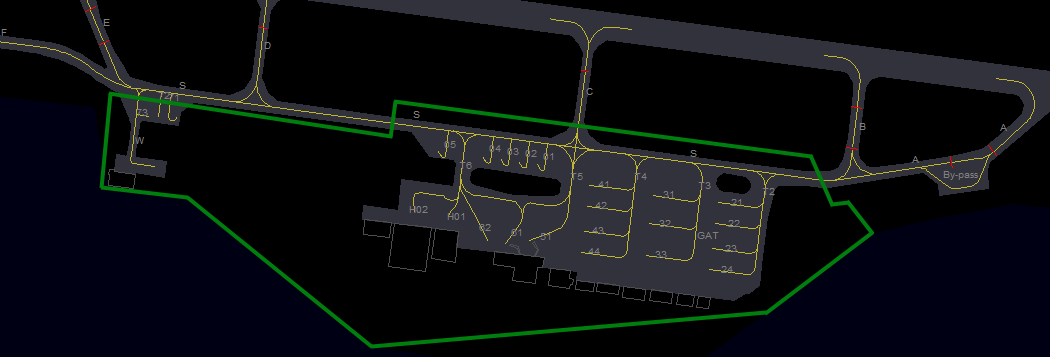](https://knowledgebase.vatsim-germany.org/uploads/images/gallery/2022-09/edde-apron.png)*Area of responsibility Erfurt Apron*
### Taxi instructions
After consultation with Erfurt Ground, all taxi movements can also be controlled outside of the apron.
#### In the presence of the ground
**Departing traffic**
- For 09 operations: aircraft are sent via taxiway S to intersection T6 (transfer to ground)
- For 27 operations: aircraft are sent to taxi stop A or B (transfer to tower)
**Incoming traffic**
- For 09 operations: Aircraft arrive on taxiway A or B directly from the tower
- For 27 operations: Aircraft arrive on taxiway S from the ground
#### In the absence of the ground
- Departing aircraft are sent directly from the apron to the runway taxi stop
- Incoming aircraft are handed over by the tower after leaving the runway
#### Special features
**Stands 21-44**
These parking spaces are so-called taxi-out stands. They are accessed via the taxiway to the east and left via the taxiway to the west.
**Stands 01-04**
These parking spaces are also taxi-out stands. They are entered and exited via S.
#### Restrictions
- **Taxiway C**
- Closed
- **Taxiway D**
- Maximum wingspan 18 m, maximum take-off mass 20 tonnes
- **Taxiway W**
- Maximum span 15 m
### Parking positions
- The terminal is located at Gates 51, 61, 62
- The GAT is located at Stands 21-24, but such aircraft can also be parked at any other position
- Apron 3 is home base to the regional police Thüringen
# Tower
#### Preferred operating direction
Due to noise abatement, the preferred runway in Erfurt-Weimar between 22:00-06:00 locally for take-offs is 27 and for landings runway 09, if the tailwind component does not exceed 5 kts. In all other cases, the runway should be decided by the respective controller depending on the weather and traffic situation.
### Control zone
The Erfurt control zone extends over the entire city of Erfurt. The vertical limit of the CTR is 3500 ft MSL. Flights into and out of the control zone take place via the mandatory reporting points:
- North: November 1 and November 2
- South: Sierra 1 and Sierra 2
[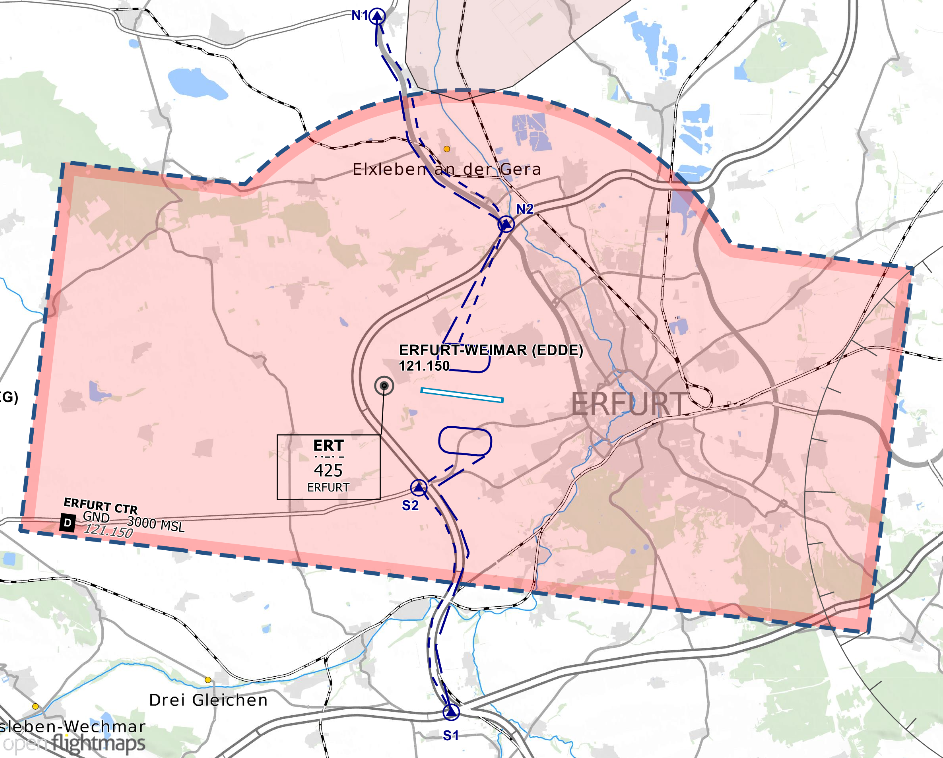](https://knowledgebase.vatsim-germany.org/uploads/images/gallery/2022-09/edde-ctr.png)*Control zone Erfurt - © [openflightmaps.org](https://www.openflightmaps.org/)*
### Incoming traffic
As the pilot vacating the runway, the tower hands over the pilot at A and B to the apron frequency and at D, E and F to the ground frequency.
The tower is responsible for ensuring that the runway, radar and/or wake turbulence separation is maintained. A go-around must be instructed immediately if the separation is about to be lost.
#### Low Visibility Procedures (LVP)
Erfurt Airport only has a CAT III on runway 27, which means that runway 27 must be used for low visibility procedures.
### Departing traffic
Runway, radar and/or wake turbulence separation must be maintained at all times. After the aircraft has taken off, the pilot switches to the departure frequency independently.
#### Low Visibility Procedures (LVP)
Low visibility take-offs are authorised at the following runway visibility ranges (RVR):
- Departing direction 27: RVR not less than 75m
- Departing direction 09: RVR not less than 125m
# EDMA - Augsburg Airport
# Overview
### Augsburg ATC Stations
| **Station**
| **Station ID**
| **Login**
| **Frequency**
| **Remark**
|
| **ATIS**
| MAX
| EDMA\_ATIS
| 119.665
| --
|
| **Tower** | MAT
| EDMA\_TWR
| 124.980
| --
|
| **München Radar**
| DMAG | EDMA\_APP | 128.255 | Augsburg Sector
**Freq coupled by online EDDM\_XX\_APP station** |
| **München Radar**
| DMNL
| EDDM\_NL\_APP
| 123.905
| North Low
**Freq coupled by online EDDM\_XX\_APP station**
|
| **München Radar**
| DMNH | EDDM\_NH\_APP | 128.030 | North high |
# Tower
Augsburg Tower is responsible for aerodrome and ground movement control at Augsburg Airport. Augsburg has a D-CTR and published IFR procedures for which no prior coordination is required for enroute clearance.
### SID Assignment
| **SID** | **Initial Climb** | **After Departure** | **Remark** |
| **MAH**
*Maisach*
| 7F | 07 | 4000 ft | Contact
München Radar
128.255
(*crosscoupled frequency*)
| - |
| 8G | 25 |
| **MIQ**
*Mike*
| 6F | 07 | 4000 ft
|
| 7G | 25 |
| **KPT**
*Kempten*
| 1F | 07 | FL 70 | Sat, Sun and Holidays only |
| 1G | 25 |
| **RIDAR** | 8F | 07 | 4000 ft | - |
| 7G | 25 |
| [**OID**](https://knowledgebase.vatsim-germany.org/books/ifr-lhx/page/enroute-clearance#bkmrk-omnidirectional-inst)
[**(Omnidirectional)**](https://knowledgebase.vatsim-germany.org/books/ifr-lhx/page/enroute-clearance#bkmrk-omnidirectional-inst)
*EDMA*
| 1E | 07 | 4000 ft | For NON-RNAV1 aircraft only, by ATC only. |
| 1W | 25 | 5000 ft |
### Taxi Guidance
Augsburg has Aprons 1-6 (with Apron 3 being the grass area to the south) and Hangars 2-8. Pilots are responsible for collision avoidance while taxiing and hovering on G and S. On all other taxiways, the tower is responsible for taxi guidance.
### Choice of operating direction
The operating direction is selected by the tower; München Radar must always be informed of the current operating direction.
Operating direction 25 is preferred and should be used in case of doubt.
### IFR departures
IFR departures shall be handed over with radar or wake turbulence separation. IFR departures over the same SID shall be handed over with 5 NM or (if higher) wake turbulence separation. The obligation of separation between IFR departures and from IFR departures to IFR approaches on a missed approach procedure lies with the tower until the transfer of communications of all flights involved.
IFR departures via Omnidirectional Departure shall be coordinated with München Radar before issuing enroute clearance.
### IFR arrivals
IFR approaches shall be handed over from München Radar to Augsburg Tower using one of the published approach procedures in compliance with radar or (if required) wake turbulence separation. The obligation of separation lies with München Radar, speed assignments from Tower are not permitted without prior coordination with München Radar.
**Runway 25:** ILS(/LOC), RNP and NDB approaches are published for runway 25. The ILS is always preferred.
**Runway 07:** Only an RNP approach is published for runway 07, which is preferred for this operating direction.
#### IFR visual approaches
IFR visual approaches are approved for both operating directions. München Radar must coordinate these with Augsburg Tower before clearance.
> Visual approaches for RWY 07 must be conducted in such a way that the final approach is at least 3 NM and the descent below 3500 ft MSL does not take place before the final approach is reached.
*AIP ED ENR 1.5/7.18*
#### Low Visibility Procedures
Low Visibility Procedures will be proclaimed by Augsburg Tower if at least one of the three criteria is met:
- RVR < 1000 m
- Ground Visibility < 1000 m
- Cloud Ceiling < 300 ft
### Usage of runway
Intersection Departures are only on this taxiways approved, if the pilot reports, that he is able:
| **RWY 07**
| **TORA** | **RWY 25** | **TORA** |
| **From rwy head** | 1406 m | **From rwy head** | 1406 m |
| **B** | 989 m | **D** | 989 m |
| **C** | 659 m | **C** | 659 m |
### VFR traffic
[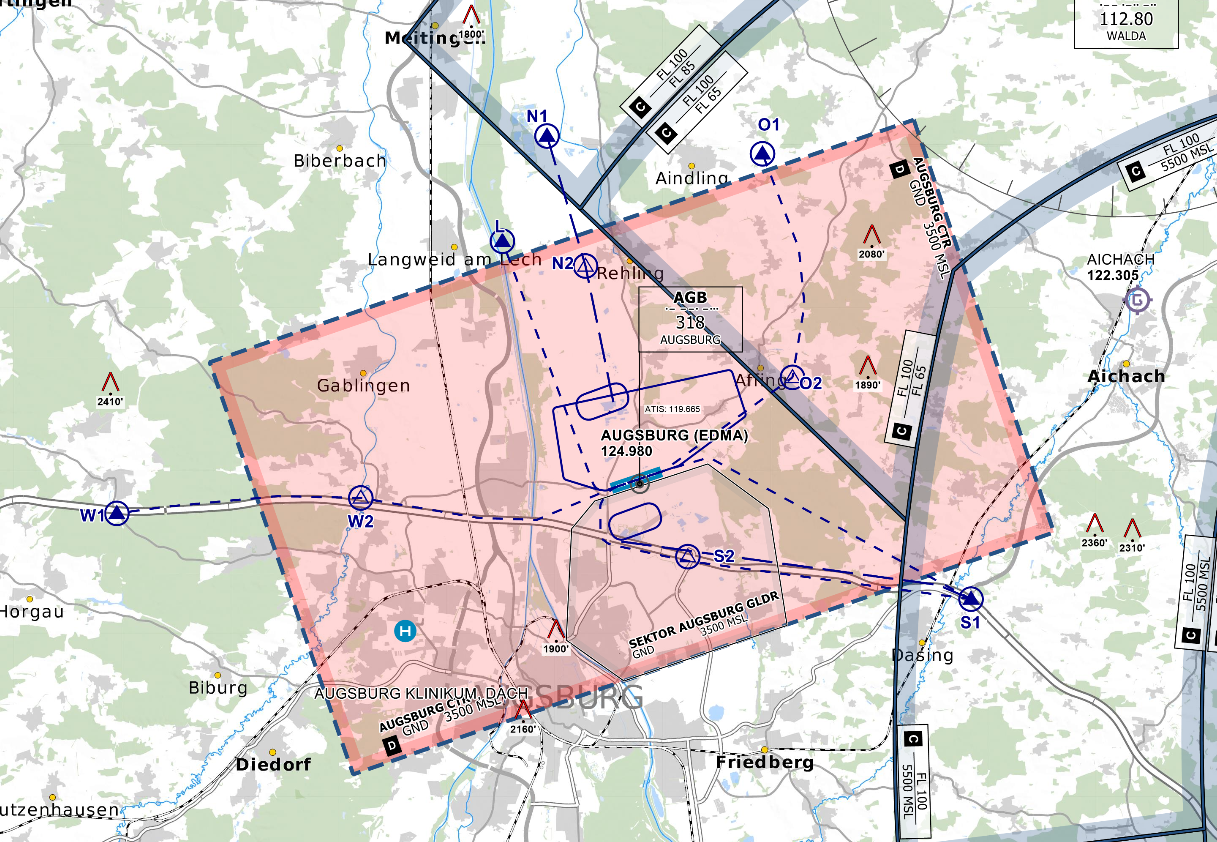](https://knowledgebase.vatsim-germany.org/uploads/images/gallery/2022-11/2022-11-28-10-43-38-mozilla-firefox.png)
#### Departures
VFR Departure routes are to be used depending on the operating direction:
- **07:** O-Routing, S1
- **25:** L-Routing, W-Routing, S-Routing (via S2 to S1)
#### Arrivals
Approaches, on the other hand, take place regardless of the operating direction via the N/S routing, which ends in a published holding procedure to the north/south of the airfield.
#### Gliding
Augsburg also has a gliding sector in the south of the control zone, which can be activated if necessary. Circuit traffic must then only be cleared in the northern circuit.
# EDMO - Oberpfaffenhofen Airport
# Overview
### Oberpfaffenhofen ATC Stations
| **Station**
| **Station ID**
| **Login**
| **Frequency**
| **Remark**
|
| **ATIS**
| MOX
| EDMO\_ATIS
| 126.580
| --
|
| **Tower** | MOT
| EDMO\_TWR
| 119.555
| --
|
| **München Radar**
| DMSL
| EDDM\_SL\_APP
| 127.955
| South Low
|
# Tower
Oberpfaffenhofen Tower is responsible for aerodrome and ground control at Oberpfaffenhofen Airport. Oberpfaffenhofen has a D(HX) CTR and published IFR procedures that do not require coordination for clearance.
However, IFR procedures are only defined for operating direction 22. Approaches can use an approach procedure to runway 22 followed by a circling for runway 04 if the tailwind is too high.
### IFR departures
IFR departures are to be handed over with radar or wake turbulence separation. IFR departures on the same SID are to be handed over with 5 NM or (if higher) wake turbulence separation. Tower is responsible for the separation between 2 IFR departures and between IFR departures and IFR approaches on a missed approach procedure until the transfer of communications of all flights involved.
#### SID assignment
| **SID** | **Initial Climb** | **After Departure** | **Remark** |
| **ATMAX**
| 2R
| 22
| FL70
| Contact München Radar 127.955
| RNAV-1 or RNP-1 or A-RNP equivalent. GPS required.
|
| **MAH**
*Maisach*
| 2R
|
| 7C
| Conventional SID
|
### IFR arrivals
IFR approaches are handed over to Oberpfaffenhofen Tower by München Radar using one of the published approach procedures, taking into account radar or (if required) wake vortex separation. The separation obligation lies with München Radar, speed assignments from Tower are not permitted without coordination with München Radar.
#### IFR-Sichtanflüge
München Radar may only clear IFR visual approaches after coordination with Oberpfaffenhofen Tower.
### Ground operation
#### General
EDMO is one of 12 special airports in federal interest, among other things, a DLR plant and research centre is located on the airport site. This circumstance is noticable in the comparatively "dismembered" ground layout.
#### Restrictions on taxiways
TWY E is 23 m wide, while TWYs A, B, C and D are each only 12.5 m wide.
#### Aprons and terminals
The GAT is located on the Main Apron in the north of the airport.
### Use of runway
Intersection takeoffs are not permitted due to a lack of distance declarations.
### Low Visibility Procedures
Oberpfaffenhofen is not approved for flight operations in visibility < 1000 m and/or main cloud bases < 200 ft; flight operations must be suspended in the event of such weather conditions.
### VFR-Verkehr
The D-CTR is surrounded by airspace E/G, while Munich Airport's airspace C is above the control zone.
[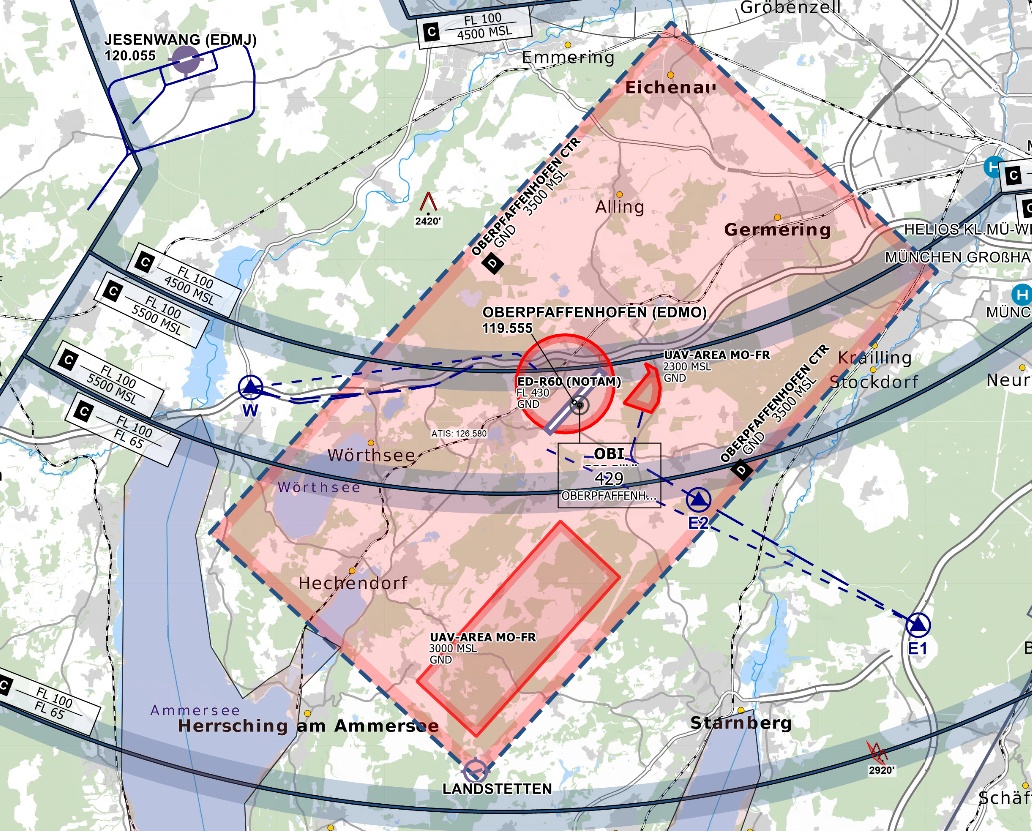](https://knowledgebase.vatsim-germany.org/uploads/images/gallery/2022-11/2022-11-28-10-30-57-mozilla-firefox.png)
### Helicopters
There is a helipad north-west of the runway.
# EDNY - Friedrichshafen Airport
# Overview
### Friedrichshafen ATC Stations
| **Station**
| **Station ID**
| **Login**
| **Frequency**
| **Remark**
|
| **ATIS**
| NYX
| EDNY\_ATIS
| 129.605
| --
|
| **Ground**
| NYG
| EDNY\_GND
| 121.600
| Not to be staffed outside organized AERO Events. |
| **Tower** | NYT
| EDNY\_TWR
| 120.080
| --
|
| **VFR Tower** | ??
| EDNY\_2\_TWR
| 134.300
| Not to be staffed outside organized AERO Events.
|
| **Alps Radar**
(Arrival)
| ARFA
| LSFA\_APP
| 119.925
| --
|
# Tower
### Cooperation with vACC Switzerland
Due to the location of Friedrichshafen Airport, there is a co-operation agreement between FIR München and vACC Switzerland that allows controllers from both sides to control at the airport.
### IFR operations
Friedrichshafen Airport is located below the so-called ARFA sector, arrivals and departures are normally controlled by Alps Radar (LSFA\_APP 119.925), which also covers this position in the absence of Friedrichshafen Tower. If this position is not staffed, the higher-level positions take over this role as follows:
EDNY\_TWR >> LSFA\_APP >> LSZH\_DEP >> LSZH\_APP >> LSAZ\_x\_CTR >> LSAS\_CTR >> EDMM\_Z\_CTR etc.
Apart from the CTR, EDNY is located in Class E airspace. A TMZ (Transponder Mandatory Zone) for VFR traffic has been established. Nevertheless, attentive airspace observation is also necessary for IFR traffic.
#### Departure Procedures
| **SID** | **Initial Climb** | **After Departure** | **Remark** |
| **ALAGO** | 7E | 06 | via SID 5000 ft
| contact
Alps Radar
119.925 when advised by Tower
| --
|
| 7W | 24 |
| **AMIKI** | 4E | 06 | nur nach LSZH
|
| 4W | 24 |
| **BEMKI** | 4E | 06 | --
|
| 4W | 24 |
| **KPT**
*Kempten*
| 6E | 06 | --
|
| 6W | 24 |
| **MOKOP** | 4E | 06 | nur lokale IFR-Flüge
|
| 3W | 24 |
| **SITOR** | 3E | 06 | nur nach LSZR
|
| 2W | 24 |
| **TRA**
*Trasadingen*
| 4E | 06 | --
|
| 3W | 24 |
Departures to the south via TRA N850 can generally expect a DCT GERSA when passing the MRVA. Departures via SID TRA #E usually do not have to fly the loop, but can expect a left DCT TRA or right DCT GERSA.
#### Arrival Procedures
| **Startpoint** | **STAR** | **RWY** | **Holding Fix** | **Course** | **Turn** | **MHA** | **Remarks** |
|---|
| **GARMO** | 2P | all | MOKOP | 248° | right | 5000 ft | GPS/FMS aircraft expect transition to final.
BRNAV and non-RNAV aircraft expect radar vectors to final.
|
| **KPT**
*Kempten*
| 7P |
| **ROLSA** | 4P |
| **ZUE**
*Zürich East*
| 5P |
#### Transitions to Final
| **Name** | **Runway** | **FAF** | **Remarks** |
|---|
| **GARMO 06** | 06 | ARGEV | Use of transition procedures only when cleared by ATC. |
| **KPT 06**
*Kempten*
|
| **ROLSA 06** |
| **ZUE 06**
*Zürich East*
|
| **GARMO 24** | 24 | ETREM |
| **KPT 24**
*Kempten*
|
| **ROLSA 24** |
| **ZUE 24**
*Zürich East*
|
Due to the low volume of traffic, RNAV transitions are rarely used. Approaches usually receive radar vectors on the final.
#### Approach Procedures
| **RWY** | **Type** | **IAF** | **IF** | **FAF/FAP** | **FAF/FAP altitude** | **Course** | **Frequency** |
|---|
| **06** | ILS Cat I | MOKOP | - | ARGEV | 4000 ft | 058° | 111.90 IFHE / D112.60 FHD |
| LOC-DME |
| RNP (LNAV, LNAV/VNAV, LPV) | RUDSI | EGNOS CH 92388 E06A |
| **24** | ILS Cat I-III | - | ETREM | 238° | 111.90 IFHW / D112.60 FHD |
| LOC-DME |
| RNP (LNAV, LNAV/VNAV, LPV) | RUDSI | EGNOS CH 42186 E24A |
ILS 06 and 24 transmit on the same frequency. In reality, the correct ILS is switched on by the tower. In the flight simulators, the correct ILS is (hopefully) set automatically depending on the direction to the airport.
#### Radar
EDNY\_TWR does not have a radar that is authorised for ATC purposes or separation. Speed assignments by TWR are only permitted after coordination with APP.
#### Squawk assignment, Departure release
WIP
#### Low visibility procedures
The ILS 24 is approved up to Cat III and can be used during LVP. EDNY\_TWR has no ground radar. To protect the ILS signal, no aircraft may park on the Liebherr apron during LVP.
#### Visual approaches and departures
EDNY is one of the very few airports in Germany where visual approaches and departures are permitted for all IFR flights, regardless of the size of the aircraft.
The following applies to visual approaches:
- Do not approach below the ILS glideslope.
- Final approach 06 should be at least 3 NM (3 DME FHD). Visual marker: Approx. 1 NM before the castle church/lake shore.
- Final approach 24 should be at least 4.5 NM (4.5 DME FHD). Visual marker: "Ravensburger Spieleland" amusement park between Ravensburg and Meckenbeuren.
Visual departures are most commonly DCT to the waypoint ALAGO, instead of flying the SID.
### VFR operation
#### Control zone Friedrichshafen
[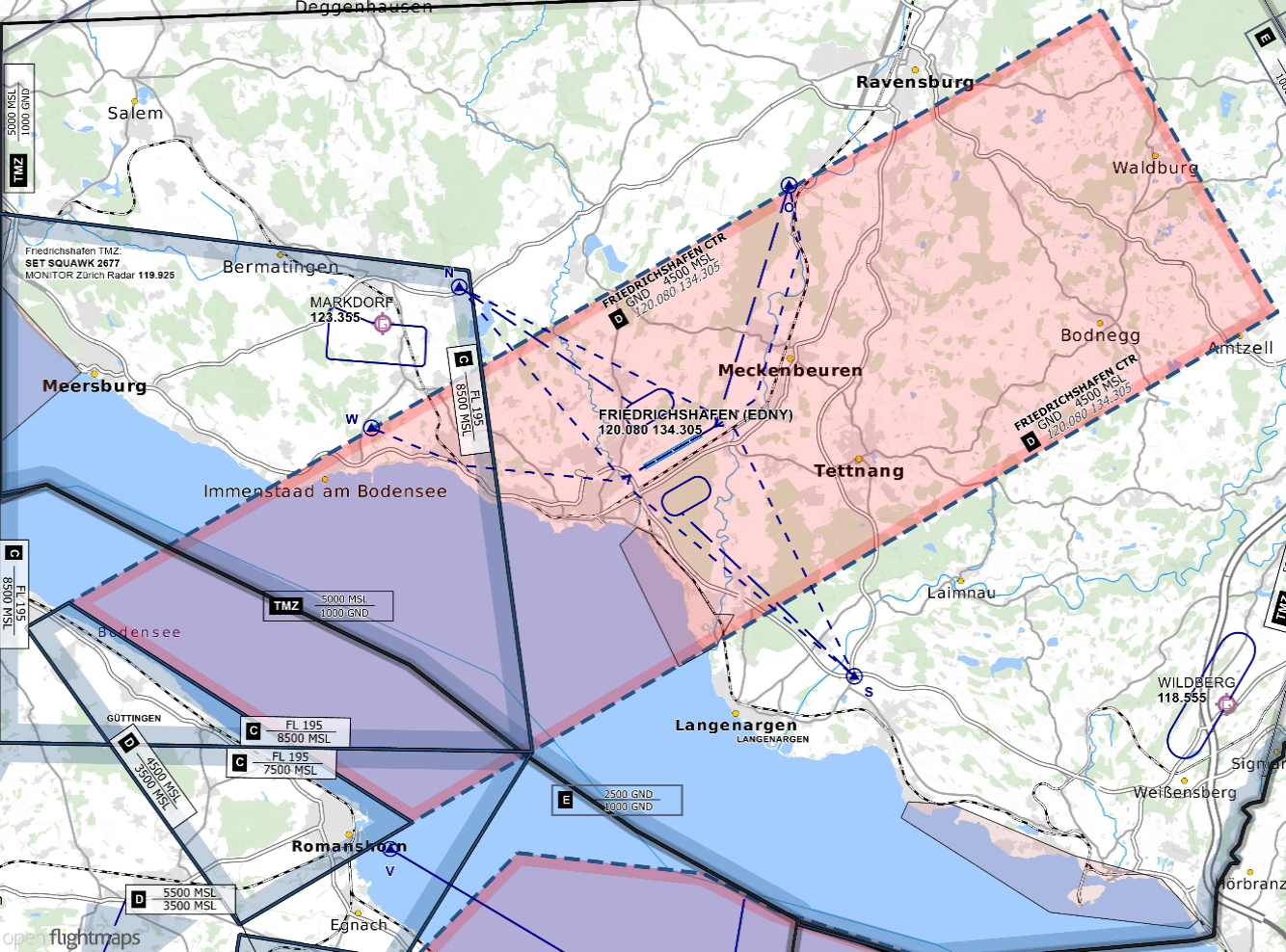](https://knowledgebase.vatsim-germany.org/uploads/images/gallery/2022-09/edny-ctr.png)*Kontrollzone Friedrichshafen- © [openflightmaps.org](https://www.openflightmaps.org/)*
Mandatory reporting points Friedrichshafen:
- **OSCAR:** West of the landfill
- **NOVEMBER:** Eastern outskirts of Markdorf, at the base of Gehrenberg mountain
- **SIERRA:** Intersection of B31 and B467 northwest of Kressbronn
- **WHISKEY:** North of the Airbus plant in Immenstaad, north-east of the three large apartment blocks on the outskirts of Immenstaad
Apart from the CTR, EDNY is located in Class E airspace. A TMZ (Transponder Mandatory Zone) has been set up to increase safety. VFR and IFR flights are not separated from each other. Attentive airspace observation is necessary. VFR flights should avoid the extended centerline and observe TMZ procedures (transponder 2677 and listen on the frequency of the position covering the airspace).
Grass runway for use by gliders only.
#### Helicopter
Helicopters take off and land on the runway, usually at Intersection D.
#### Zeppelins
Zeppelin NT airships carry out daily VFR sightseeing flights around Lake Constance from spring to autumn. Two zeppelins are often on the move, especially at peak times at weekends.
Zeppelins carry out direct approaches and departures to their anchor masts north of the RWY. Otherwise they are to be treated as normal VFR traffic. Due to the circular flight routes, deviations from the mandatory reporting points are often requested (e.g. along the shore) and are usually not a problem - the pilots know their way around.
#### Verfahren zur AERO
There is a lot of VFR traffic during the annual Aero Fair in April. The exact procedures will be published in the AIP SUP. (AERO 2023: [AIP SUP VFR](https://www.bodensee-airport.eu/content/uploads/2023/03/AIP-SUP-VFR.pdf), [AIP SUP IFR](https://www.bodensee-airport.eu/content/uploads/2023/03/AIP-SUP-IFR.pdf))
Additional stations are set up:
- EDNY\_1\_TWR (120.075) acts as a pick-up. Takes the initial calls from approaching VFR flights, distributes them to the entry points and manages the holds if necessary. Then hands them over to 2\_TWR.
- EDNY\_2\_TWR (134.300) issues entry authorisation to the CTR and otherwise handles the control zone as usual, including IFR traffic.
- EDNY\_GND (121.600) - Ground
NOVEMBER is generally used for VFR approaches. The southern half of the grass runway may only be used by helicopters.
Together with the approaches via NOVEMBER, departures follow a one-way system:
- RWY 24: Departures via WHISKEY and SIERRA
- RWY 06: Departures via OSCAR and SIERRA
Approaches via SIERRA are generally not possible. Aircraft coming from the south must fly around the CTR in the east and cross IFR final approach 24, which can be risky.
The runway should be exited via TWY E/F or C/B and the touchdown point should be selected accordingly by the PIC to ensure a rapid roll-off. Exiting the runway via D/M is not permitted. Additional grass parking areas are provided in the northern part of the airport and on both sides of the former TWY S (which will then be used again). TWY D & M are used to cross the runway as access to the northern car parks and the exhibition grounds. Direct taxiing to the exhibition centre via TWY M is possible for exhibitors after the road is closed.
### Ground operation
All parking positions are "self-manoeuvring". Pushback is not available. Stands 201-206 are code C (B737/A32x families). Parking of Code D aircraft (A300, B767) is only possible in exceptional cases and only at position 201.
There is no GAT. All crews and passengers must use the normal terminal.
Machines with home base EDNY are parked at their respective hangars:
- The hangar of the Luftsportclub (LSC) has an access taxiway between stands 203 and 204 (not in the sector file).
- The Liebherr apron is only used by Liebherr aircraft.
- Additional private hangars at Apron 1 and 4.
External aircraft up to 5.7 tonnes usually park on the north side of Apron 3 or - if full - on Apron 4. Smaller business jets (Citation or similar) usually park on Apron 1. Large business jets with a short turnaround usually park on Stands 204-206. For longer stays on Apron 4 and Apron 3 (western part).
[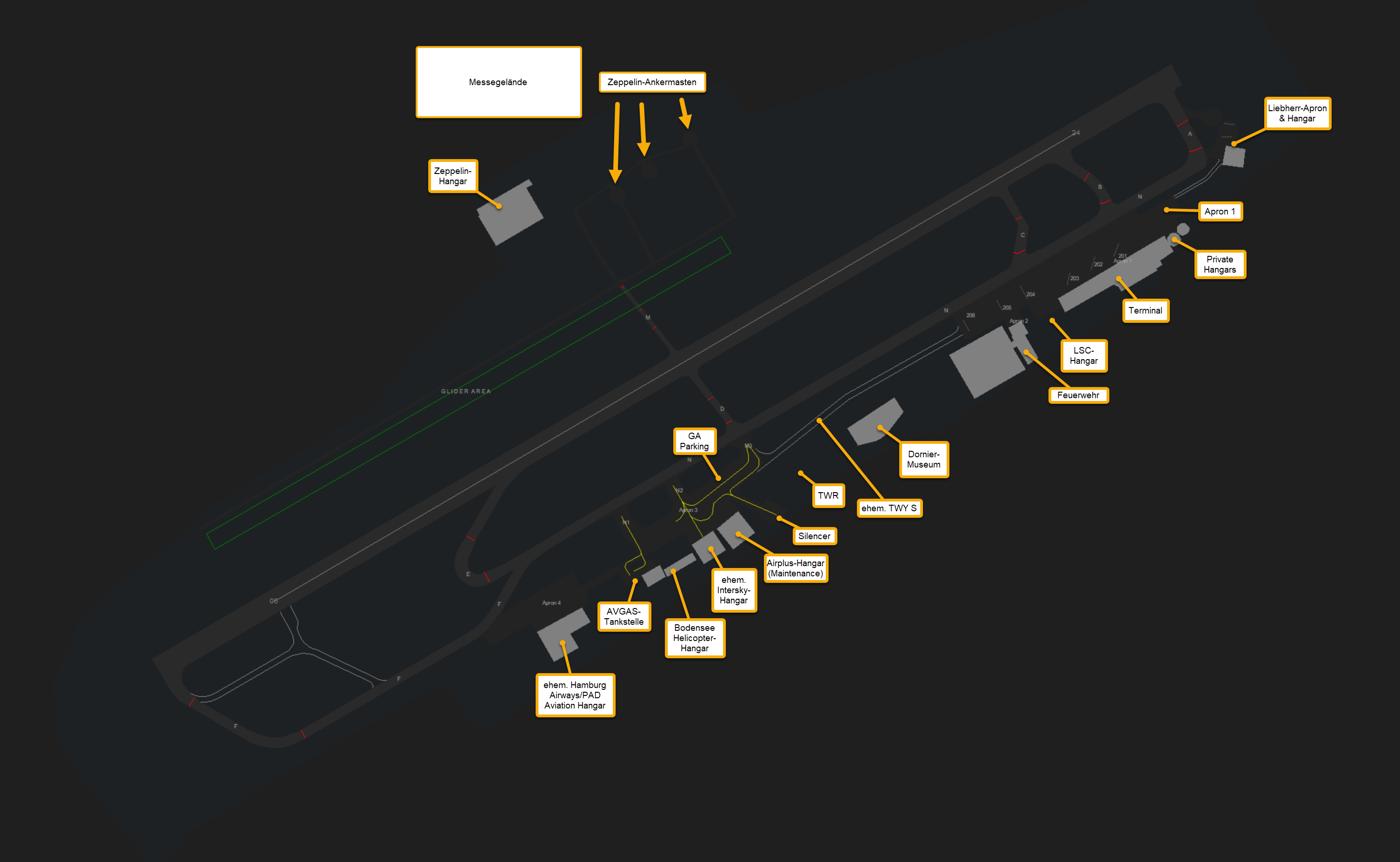](https://knowledgebase.vatsim-germany.org/uploads/images/gallery/2022-09/edny-briefing.png)
# EDQM - Hof-Plauen Airport
# Overview
### Hof-Plauen ATC Stations
| **Station**
| **Station ID**
| **Login**
| **Frequency**
| **Remark**
|
| **Tower** | QMT | EDQM\_TWR
| 124.355
| --
|
| **München Radar**
| FRK
| EDDN\_FRK\_APP
| 129.525
| Franken Low
|
# Tower
Hof Tower is responsible for aerodrome and ground control at Hof-Plauen Airport. Hof-Plauen has a D(HX) CTR and published IFR procedures that do not require coordination for clearance.
### SID Assignment
| **SID** | **Initial Climb** | **After Departure** | **Remark** |
| **ABERU** | 1S | 08 | FL70 | Contact
München Radar
129.525
| -
|
| 2T | 26 |
| **KULOK**
| 1S | 08 | 5000 ft
|
| 2T | 26 |
| **LASGA** | 1S | 08 | FL 70
|
| 2T | 26 |
| **PEROX** | 1S | 08 |
| 2T | 26 |
| **TABAT
| 1S | 08
|
| 2T | 26
|
### Operating direction
The operating direction is selected by the tower; München Radar (FRK) must always be informed of the current operating direction.
### IFR departures
IFR departures are to be handed over with radar or wake turbulence separation. IFR departures on the same SID are to be handed over with 5 NM or (if higher) wake turbulence separation. Tower is responsible for the separation between 2 IFR departures and between IFR departures and IFR approaches on a missed approach procedure until the transfer of communications of all flights involved.
### IFR arrivals
IFR approaches are handed over from München Radar to Hof Tower using one of the published approach procedures in compliance with radar or (if required) wake turbulence separation. München Radar is responsible for the separation, speed assignments from the tower are not permitted without coordination with München Radar.
**Both runway directions** are equipped with an RNP approach.
#### IFR visual approaches
IFR visual approaches are approved for both operating directions without further regulations. München Radar must coordinate these with Hof Tower prior to clearance.
#### Low Visibility Procedures
There are no defined low visibility procedures in Hof. If the minima cannot be adhered to, no flights are possible.
### Use of runway
For operating direction 08, a backtrack generally required. Smaller aircraft can depart directly from intersection B.
### VFR traffic
[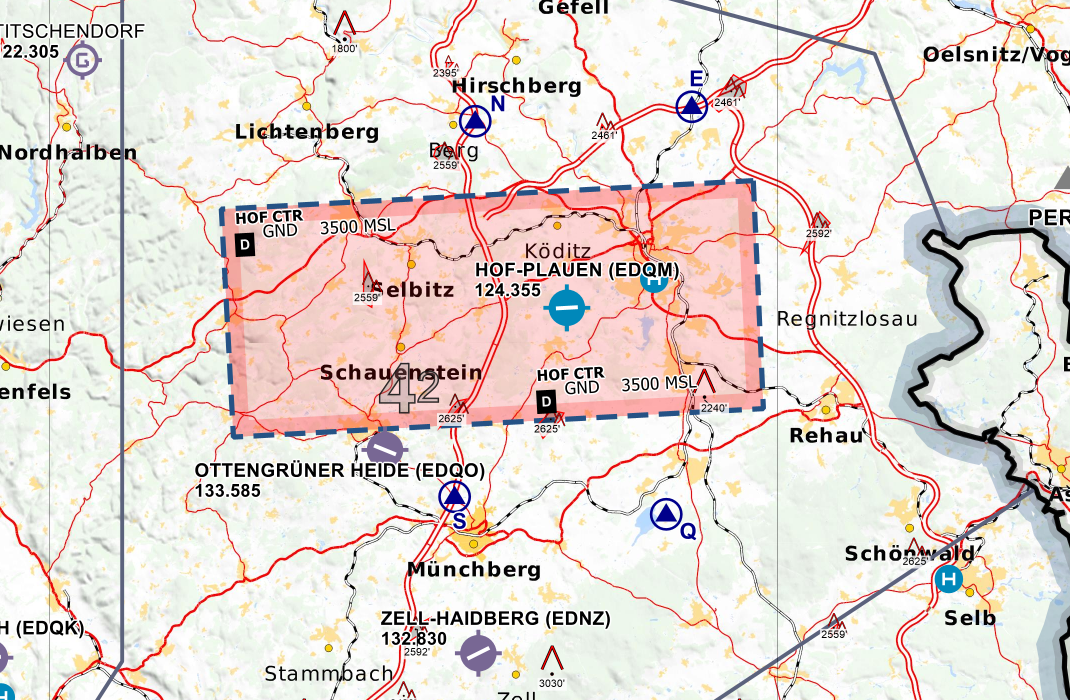](https://knowledgebase.vatsim-germany.org/uploads/images/gallery/2023-01/2023-01-07-10-24-53-mozilla-firefox.png)
#### Arrivals and departures
Arrivals and departures take place via the published mandatory reporting points or can be instructed individually. There are no published holding procedures for VFR within the control zone.
# ETSI - Ingolstadt/Manching
# Overview
Ingolstadt/Manching is a military airfield with Civil Joint User south of Ingolstadt which is home of the “Wehrtechnische Dienststelle für Luftfahrzeuge und Luftfahrtgerät der Bundeswehr” (WTD 61) by the German Air Force. For the most part, Ingolstadt handles Military Jet traffic, Helicopter traffic and civilian GA. There are multiple Restricted Areas around Ingolstadt in which the Military aircrafts perform Testflights.
Charts can be found in the [MIL AIS](https://www.milais.org/).
• VFR Charts: Library → Under Publication select “[GEMIL FLIP VAD](https://www.milais.org/publications.php)” → Ingolstadt/Manching
• IFR Charts: Library → CENOR FLIP→ [Aerodromes ](https://www.milais.org/cenor.php?ZnJtaWQ9MA==)→ Ingolstadt/Manching
### Ingolstadt/Manching ATC Stations
| **Station**
| **Station ID**
| **Login**
| **Frequency**
|
| **ATIS**
| SX
| ETSI\_ATIS | 118.865
|
| **Tower**
| SIT
| ETSI\_TWR
| 125.255
|
| **Radar**
| SIA | ETSI\_APP
| 120.605
|
# Tower
Ingolstadt Tower is a military station and is responsible for airfield control at Ingolstadt Airport.
Ingolstadt has a D-CTR and military departure procedures. Enroute clearances must be issued by Munich Radar and then relayed to the departure by Ingolstadt Tower.
### Runways
Preferred runway for civilian traffic and military traffic is the southern runway 24L/06R. Runway 24R/06L should only be used by Military aircraft or UAVs.
### Airbus Defence and Space
The apron of Airbus Defence and Space is located in the southwestern part of Ingolstadt airport. It’s a separate Apron that is under the jurisdiction of Airbus and is connected by six Gates to taxiway S. The Apron itself is uncontrolled and aircraft will call for Taxi with the requested Gate on which they want to leave the Apron. Normally the gates are used by the following types:
- Gate 1: Airbus Beluga XL
- Gate 2: Airbus Beluga XL/ST, A400M, E3 AWACS
- Gate 3: -
- Gate 4: TOR, EUFI
- Gate 5 +6: Towing of TOR/EUFI, Museum Aircraft of the Messerschmitt Museum
[](https://knowledgebase.vatsim-germany.org/uploads/images/gallery/2024-08/Qc4grafik.png)
#### Beluga Operation
The Airbus Beluga visits Ingolstadt frequently and has two designated parking positions on the Airbus Apron. The most frequently used position can be accessed via Gate 1, this position however can only be used for the Beluga XL!
The second position can be accessed via Gate 2 and is suitable for the Beluga ST and Beluga XL.
The Beluga is not allowed to start its engines in the vicinity of the Airbus Apron, it needs to pushback onto TWY S before starting it's engines - this procedure applies to both parking positions.
[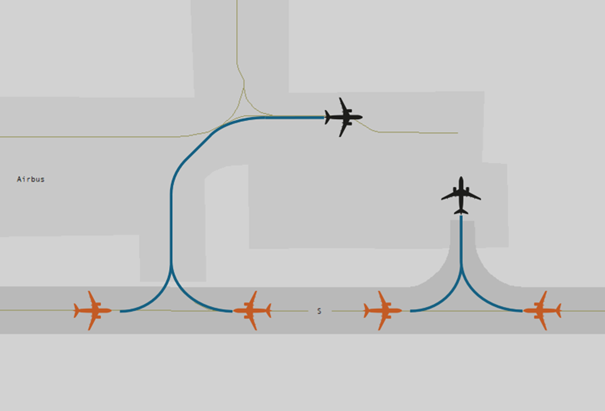](https://knowledgebase.vatsim-germany.org/uploads/images/gallery/2024-08/ZI4grafik.png)
# Military Approach - Ingo Radar
### Area of Responsibility
Ingo Radar operates within the so called "AoR Altmühl". Lateral and vertical extension of AoR Altmühl is shown in the chart below. The activation of AoR Altmühl has the be announced to surrounding München ACC/APP stations prior activation.
The ROKIL sector south of AoR Altmühl is a part of the sector of DMNL and can be activated on request of Ingo Radar. If active, Ingo Radar may use the ROKIL sector up to 4000 ft and without maintaining lateral distance to the boundary. DMNL shall apply 3 NM lateral distance to the airspace boundary.

### Coordination Procedures
#### IFR-Departures from ETSI
Ingo Tower shall obtain enroute clearance for IFR departures from the station covering München ACC sector SWA. Departures are subject to a departure release from Ingo Radar.
| *Coordination between Ingo Tower and SWA.*
|
| SWA
| Schwaben, go ahead.
|
| Ingo Tower
| Ingo Tower, request enroute clearance for GAF123.
|
| SWA
| GAF123 is cleared to Holzdorf aerodrome via UPALA, flight planned route, squawk 2056.
|
| Ingo Tower
| *(*Readback*)*, (Initials).
|
| SWA
| (Initials).
|
| *Relaying clearance to aircraft.*
|
| Ingo Tower
| GAF123, report ready to copy enroute clearance.
|
| GAF123
| Go ahead, GAF123.
|
| Ingo Tower
| GAF123, cleared to Holzdorf via SI124 \[Sierra India One Two Four\] departure, right turn to UPALA, flight planned route, squawk 2056, when airborne contact Ingo Radar on 120.600. |
| GAF123
| *(*Readback*)*, GAF123.
|
| *Coordination between Ingo Tower and Ingo Radar.*
|
| Ingo Radar
| Ingo Radar, servus.
|
| Ingo Tower
| Ingo Tower, request release GAF123.
|
| Ingo Radar
| GAF123 released, (Initials).
|
| Ingo Tower
| (Initials).
|
Departures ETSI via OID SI124 and SI224 flying a northbound routing after OID are released for climb and right turn by DMNL.
Handover conditions from Ingo Radar to ACC/APP München shall be coordinated individually.
#### IFR-Departures from ETSN
Neuburg Tower shall obtain enroute clearance for IFR departures from the station covering München ACC sector SWA. Departures are subject to a departure release from Ingo Radar.
Westbound departures ETSN via IOD SN127 may be applied without coordination between Ingo Radar and DMNL up to FL070.
#### IFR-Arrivals to ETSI
# ATIS Codes EDMM
Voraussetzung für das Schalten der ATIS ist das Einloggen auf eine Station des jeweiligen Airports. Danach kann über einen Klick auf den (zuletzt aktiven) ATIS-Designator, in diesem konkreten Fall "K", der *ATIS Setup Dialog* aufgerufen werden:
[](https://knowledgebase.vatsim-germany.org/uploads/images/gallery/2022-10/edmm-kopfleiste-euroscope-atis.JPG)
Dieser öffnet sich und sieht beispielhaft so aus:
[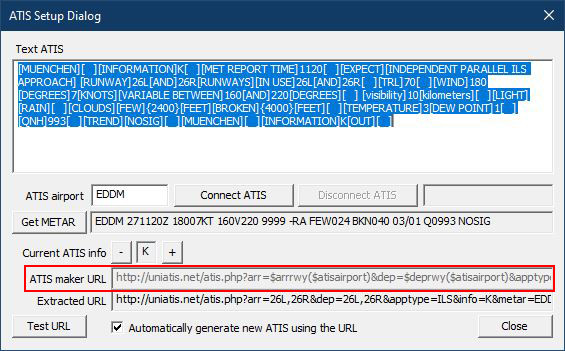](https://knowledgebase.vatsim-germany.org/uploads/images/gallery/2022-10/eddm-atis-setup-dialog-1.jpg)
Was uns für die weiteren Schritte interessiert ist die eingerahmte Zeile *ATIS maker URL*. Um diese Informationen zu ändern bzw. zu ergänzen ist es unerheblich ob die ATIS derzeit konnektiert ist oder nicht. Wichtig ist, den Haken vor der Zeile *Automatically generate new ATIS using the URL* zu entfernen:
[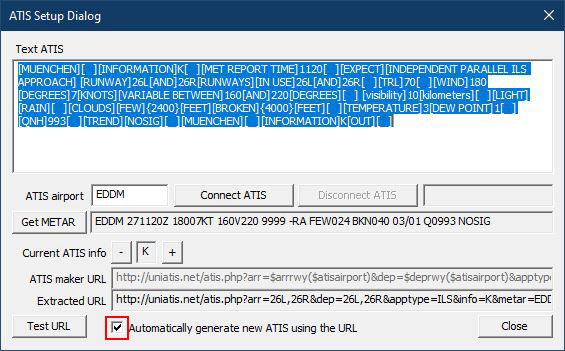](https://knowledgebase.vatsim-germany.org/uploads/images/gallery/2022-10/edmm-atis-setup-dialog-2.jpg)
Nunmehr wird die Zeile *ATIS maker URL* weiß mit schwarzer Schrift dargestellt und kann manuell bearbeitet werden. Dabei geht es darum sogenannte *ATIS Maker* zu ergänzen die in den nachfolgenden Abschnitten aufgeführt sind.
### Anwendbare URL-Parameter
Wie den bereits vorhandenen ATIS Makern zu entnehmen ist beginnen diese immer mit einem "&" ergänzt um einen Text. Vergleichbar ist das mit einem Alias. Dabei können mehrere ATIS Maker aneinander gereiht werden. Wir werden unsere Ergänzungen immer an das Ende der Zeile anfügen um die Sinnhaftigkeit und Struktur der ATIS nicht zu gefährden.
In den folgenden Abschnitten sind einige ATIS Beispiele zu finden und mit dem roten Text hervorgehoben wie der ATIS Maker aufgelöst wird.
#### EDDM
Die folgenden Parameter sind nur in EDDM benutzbar.
##### LVP - Low Visibility Operations
**&lvp** und die DEP/ARR Runways vorher in Euroscope entsprechend einstellen.
> `MUENCHEN INFORMATION F AUTOMATIC MET REPORT TIME 1620 LOW VISIBILITY PROCEDURES IN OPERATION CAT II AND III AVAILABLE EXPECT VECTORS FOR ILS APPROACH MAIN LANDING RUNWAY 08L MAIN DEPARTURE RUNWAY 08R TRL 60 WIND 100 DEGREES 5 KNOTS VISIBILITY 5 KILOMETERS LIGHT RAIN AND DRIZZLE MIST CLOUDS BROKEN 500 FEET TEMPERATURE 2 DEW POINT 1 QNH 1017 TREND TEMPORARY VISIBILITY 4000 METERS CLOUDS BROKEN 400 FEET MUENCHEN INFORMATION F OUT`
##### GTO - Guided Take Off
**>o**
> `MUENCHEN INFORMATION F AUTOMATIC MET REPORT TIME 1620 LOW VISIBILITY PROCEDURES IN OPERATION CAT III AND GUIDED TAKE-OFF AVAILABLE FOR RUNWAY 08L EXPECT VECTORS FOR ILS APPROACH RUNWAY 08R RUNWAYS IN USE 08L AND 08R TRL 60 WIND 100 DEGREES 5 KNOTS VISIBILITY 5 KILOMETERS LIGHT RAIN AND DRIZZLE MIST CLOUDS BROKEN 500 FEET TEMPERATURE 2 DEW POINT 1 QNH 1017 TREND TEMPORARY VISIBILITY 4000 METERS CLOUDS BROKEN 400 FEET MUENCHEN INFORMATION F OUT`
##### Windshear
**&windshear08** oder **&windshear26**
> `MUENCHEN INFORMATION G AUTOMATIC MET REPORT TIME 1650 EXPECT VECTORS FOR INDEPENDENT PARALLEL ILS APPROACH RUNWAY 08L AND 08R RUNWAYS IN USE 08L AND 08R TRL 60 WIND 110 DEGREES 4 KNOTS VISIBILITY 6 KILOMETERS LIGHT RAIN CLOUDS BROKEN 500 FEET OVERCAST 800 FEET TEMPERATURE 2 DEW POINT 1 QNH 1017 TREND TEMPORARY VISIBILITY 4000 METERS CLOUDS BROKEN 400 FEET WINDSHEAR RUNWAY 08L AND 08R MUENCHEN INFORMATION G OUT`
##### Birds
**&birds08** oder **&birds26**
> `MUENCHEN INFORMATION G AUTOMATIC MET REPORT TIME 1650 EXPECT VECTORS FOR INDEPENDENT PARALLEL ILS APPROACH RUNWAY 08L AND 08R RUNWAYS IN USE 08L AND 08R TRL 60 WIND 110 DEGREES 4 KNOTS VISIBILITY 6 KILOMETERS LIGHT RAIN CLOUDS BROKEN 500 FEET OVERCAST 800 FEET TEMPERATURE 2 DEW POINT 1 QNH 1017 TREND TEMPORARY VISIBILITY 4000 METERS CLOUDS BROKEN 400 FEET BIRDS OBSERVED IN VICINITY OF RUNWAYS 08L AND 08R MUENCHEN INFORMATION G OUT`
##### De-Icing
**&deice**
> `MUENCHEN INFORMATION G AUTOMATIC MET REPORT TIME 1650 EXPECT VECTORS FOR INDEPENDENT PARALLEL ILS APPROACH RUNWAY 08L AND 08R RUNWAYS IN USE 08L AND 08R TRL 60 WIND 110 DEGREES 4 KNOTS VISIBILITY 6 KILOMETERS LIGHT RAIN CLOUDS BROKEN 500 FEET OVERCAST 800 FEET TEMPERATURE 2 DEW POINT 1 QNH 1017 TREND TEMPORARY VISIBILITY 4000 METERS CLOUDS BROKEN 400 FEET REPORT IF DEICING REQUIRED PRIOR STARTUP ON DEICING COORDINATOR FREQUENCY 121.990 MUENCHEN INFORMATION G OUT`
#### Minors
Folgende Parameter sind nur für unsere Minor Airports anwendbar. Dies sind derzeit: EDDN, EDMA, EDMO, EDJA, EDNY
##### LVP - Low Visibility Operations
Nur in EDDN wird bei entsprechenden Bedingungen im METAR automatisch LVP in der ATIS gesetzt.
> `NUERNBERG INFORMATION A AUTOMATIC MET REPORT TIME 1450 EXPECT VECTORS FOR ILS APPROACH RUNWAY IN USE 28 TRL 60 WIND 270 DEGREES 2 KNOTS VISIBILITY 500 METERS RUNWAY 28 LOW-VISIBILITY PROCEDURES CAT II IN OPERATION CLOUDS OVERCAST 100 FEET TEMPERATURE 0 DEW POINT -1 QNH 1026 hpa OR 3030 inches TREND NOSIG NUERNBERG INFORMATION A OUT`
##### Departure Frequency
**&depfreq=122.8** für Unicom oder **&depfreq=129.525** mit der jeweiligen Radar Frequenz
> `NUERNBERG INFORMATION A AUTOMATIC MET REPORT TIME 1450 EXPECT VECTORS FOR ILS APPROACH RUNWAY IN USE 28 TRL 60 ATTENTION! DEPARTURE FREQUENCY FOR ALL DEPARTING AIRCRAFT IS MUENCHEN RADAR ON FREQUENCY 129.525 WIND 270 DEGREES 4 KNOTS VISIBILITY 9 KILOMETERS CLOUDS OVERCAST 1200 FEET TEMPERATURE 0 DEW POINT -2 QNH 1026 hpa OR 3030 inches TREND NOSIG NUERNBERG INFORMATION A OUT`
##### EDNY AERO Ops
- **&vfrarrfreq=120.080** falls zwei Tower online sind
- **&vfrarrroute=NOVEMBER** zum bestimmen über welche Route VFR Verkehr den Einflug erwarten soll
> `FRIEDRICHSHAFEN INFORMATION R MET REPORT TIME 2050 AUTOMATED WEATHER MESSAGE EXPECT ILS APPROACH RUNWAY 06 EXPECT VFR ARRIVAL VIA ROUTE NOVEMBER RUNWAYS IN USE 06 TRL 60 ATTENTION! DEPARTURE FREQUENCY FOR ALL DEPARTING AIRCRAFT IS UNICOM ON FREQUENCY 122.8 VFR ARRIVALS CONTACT FRIEDRICHSHAFEN TOWER ON FREQUENCY 120.080 TO ENTER CTR WIND 030 DEGREES 6 KNOTS VARIABLE BETWEEN 340 AND 070 DEGREES VISIBILITY 10 KILOMETERS NO CLOUD DETECTED TEMPERATURE 9 DEW POINT 6 QNH 1020 FRIEDRICHSHAFEN INFORMATION R OUT`
## Abschließende Arbeiten
Schlussendlich darf natürlich nicht vergessen werden, den Haken vor der Zeile *Automatically generate new ATIS using the URL* wieder zu setzen und mit einem Klick auf die Schaltfläche *Test URL* die ATIS bereitzustellen. Welche Informationen enthalten sind, lässt sich in dem großen Feld *Text ATIS* kontrollieren.
[](https://knowledgebase.vatsim-germany.org/uploads/images/gallery/2022-10/edmm-atis-setup-dialog-3.jpg)
Bitte auch an der Stelle nochmal überprüfen, ob die ATIS auch auf der richtigen Frequenz arbeitet und nicht im Feld neben dem ATIS Buchstaben die bekannte *199.998* steht.